-
Posts
866 -
Joined
-
Last visited
Content Type
Profiles
Forums
Gallery
Events
Posts posted by Jond
-
-
Post 31
Stands chain and work crew
I believe that telling the story of the railway and how it works is a key part of this build. It has been here and active for 150 years and quite a marvel. In normal years there are many different large yachts, tugs, science boats and schooners that come up for underwater work. For the past 5 plus years the yard has been fully dedicated to this re build of Ernestina and that is what we are trying to show.
Stands
For the full story one needs to go back to photos 144 and 145 to see the stands engaged against the hull when Ernestina was hauled. Once the planking and framing was removed and the hull rebuilt, the stands needed to be rebuilt to facilitate launching.
-
316
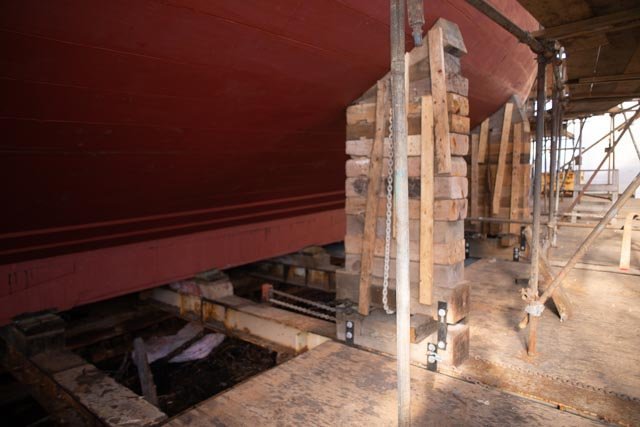 here is a new built-up stand that supports the hull after the planking is done. At this point all the painting is done and the stands are in position ready for launch. There are five of the eight on each side engaged. The chains on the deck allow the stand to be pulled away from the hull after the schooner is in the water and started to float free.
here is a new built-up stand that supports the hull after the planking is done. At this point all the painting is done and the stands are in position ready for launch. There are five of the eight on each side engaged. The chains on the deck allow the stand to be pulled away from the hull after the schooner is in the water and started to float free.
-
317
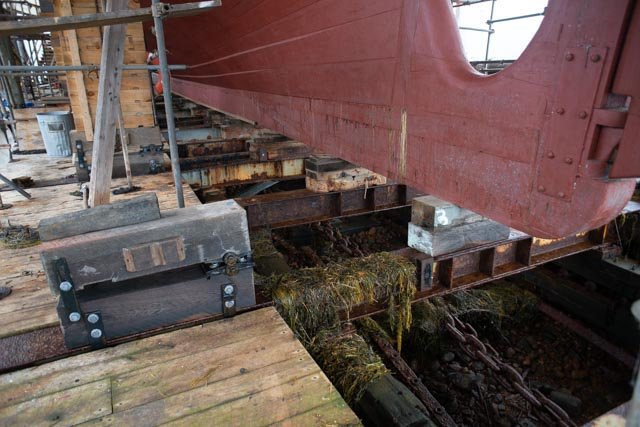 here we see at the aft end the base is in place. there is a 6x6 post beyond. This view of the base is how I plan to show the five active units because before completing planking poles were used and continuously relocated to allow planking. Those bases at the extreme ends were laid aside to allow better access.
here we see at the aft end the base is in place. there is a 6x6 post beyond. This view of the base is how I plan to show the five active units because before completing planking poles were used and continuously relocated to allow planking. Those bases at the extreme ends were laid aside to allow better access.
Chains and tide
-
318
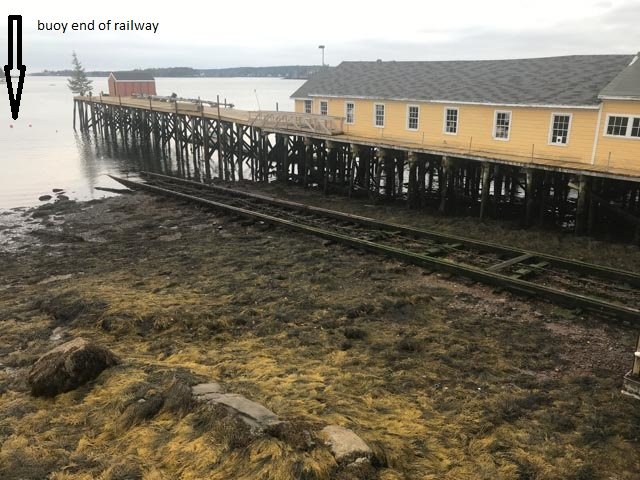 In this view we are need a low tide. We can see the red buoys marking the end of the railway. The dock in this view is shown on the edge of the diorama to help orient the viewer. See the tide marking on the piling. We have 9–10-foot tides in the harbor.
In this view we are need a low tide. We can see the red buoys marking the end of the railway. The dock in this view is shown on the edge of the diorama to help orient the viewer. See the tide marking on the piling. We have 9–10-foot tides in the harbor.
-
319
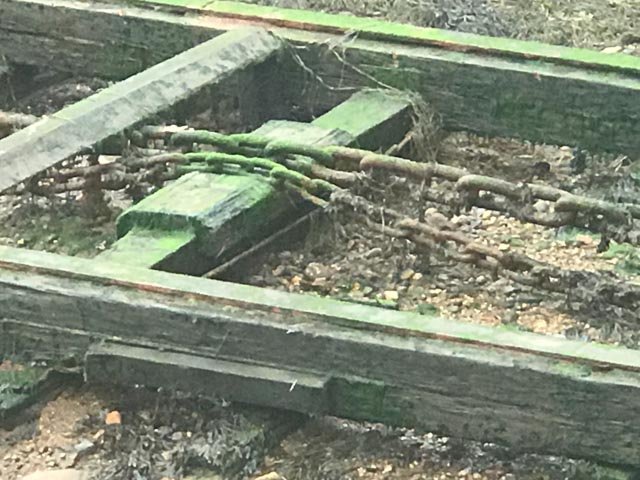 here is a closeup of the chains laying out into the harbor. The large chain does not go all the way out. The smaller chain is hooked to it and rounds a sheave underwater.
here is a closeup of the chains laying out into the harbor. The large chain does not go all the way out. The smaller chain is hooked to it and rounds a sheave underwater.
-
320
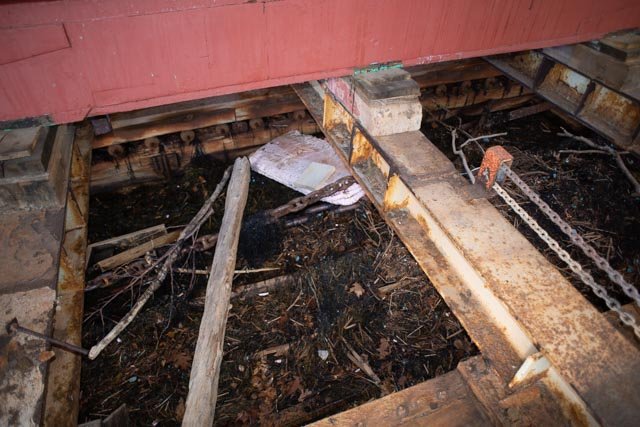 here the smaller chain hooks into the railway car about 2/3 the way forward. Is is used to pull the car down the slope into the water at launch. The bigger chain continues up and into the windlass for hauling either out or in and connects to the front to the car. Note the large amount of seaweed even this far up the railway.
here the smaller chain hooks into the railway car about 2/3 the way forward. Is is used to pull the car down the slope into the water at launch. The bigger chain continues up and into the windlass for hauling either out or in and connects to the front to the car. Note the large amount of seaweed even this far up the railway.
-
321
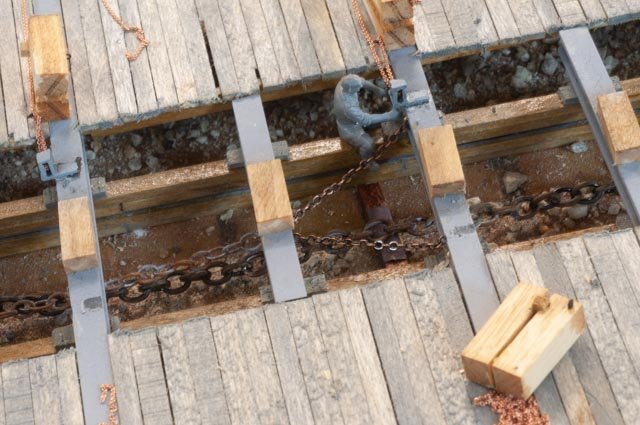 here I have connected the smaller chain to the car. One of the work crew decided to check it out.
here I have connected the smaller chain to the car. One of the work crew decided to check it out.
-
322
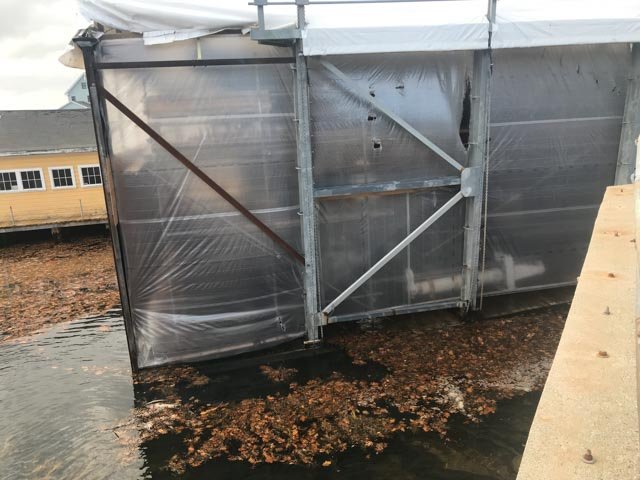 this view is a typical near high tide. The water came in and up to the deck of the railway most tides. I debated what to do and deferred to the easier low tide approach.
this view is a typical near high tide. The water came in and up to the deck of the railway most tides. I debated what to do and deferred to the easier low tide approach.
The work crew arrives
-
323
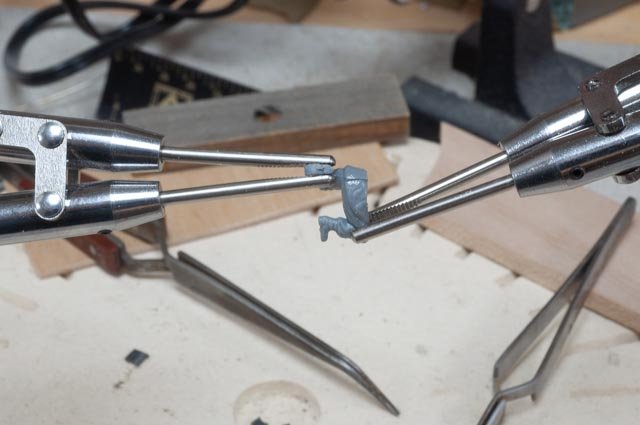 I went to eBay and found a model kit of 9 German army tank workman and thought to give it a try. I filed off their soft hats and roughed up some of their uniforms before painting.
I went to eBay and found a model kit of 9 German army tank workman and thought to give it a try. I filed off their soft hats and roughed up some of their uniforms before painting.
-
324
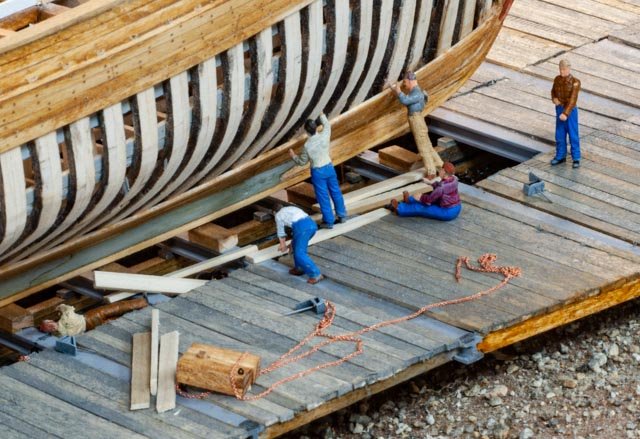 I think I want to show a bunch of them working on the hull planking. It was funny as the loose schooner kept sliding and knocking the guys down. I need to fix that oops.
I think I want to show a bunch of them working on the hull planking. It was funny as the loose schooner kept sliding and knocking the guys down. I need to fix that oops.
-
325
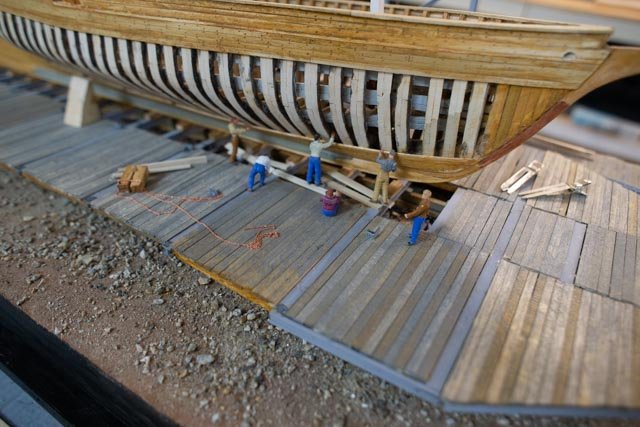 here is the planking crew
here is the planking crew
-
326
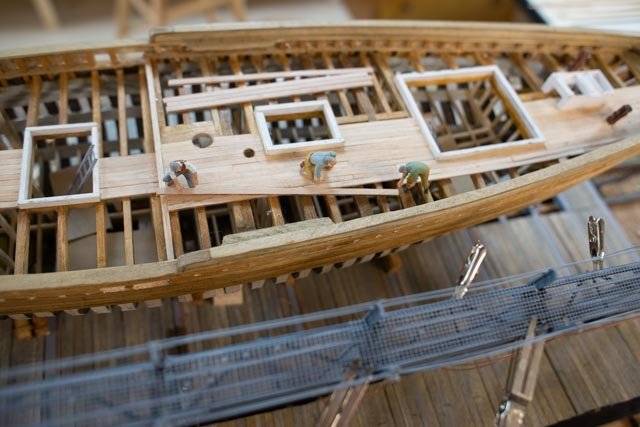 here is the decking crew
here is the decking crew
-
327
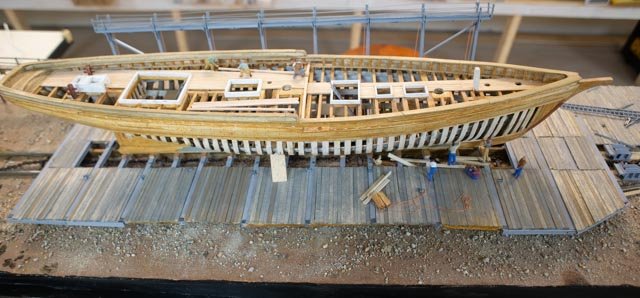 Here we see both, and the new black pained trim around the diorama.
Here we see both, and the new black pained trim around the diorama.
Next up
I realize I need to set the schooner on the railway permanently. That means any work needing to apply force needs to be done. Therefore, by next week. work on the schooner per say will be wrapped up and the remainder will focus on details and the overall story of rebuilding. Finally, I need to complete the diorama parts, painting and seaweed etc.
- Richvee, Keith Black, Siggi52 and 1 other
-
 4
4
-
316
-
Post 30
Setting the first steel platform
Saturday was exciting, as I took the plunge and set the first dockside platform.
-
306
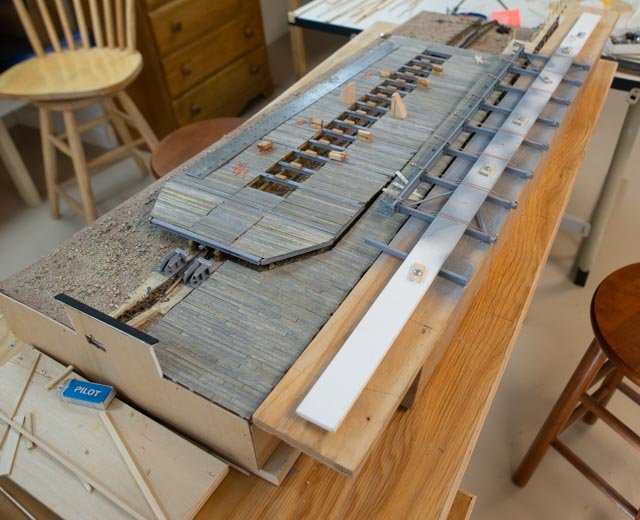 here I have laid down the assembled platform and attached all eight of the small chains assemblies to operate the stands.
here I have laid down the assembled platform and attached all eight of the small chains assemblies to operate the stands.
-
307
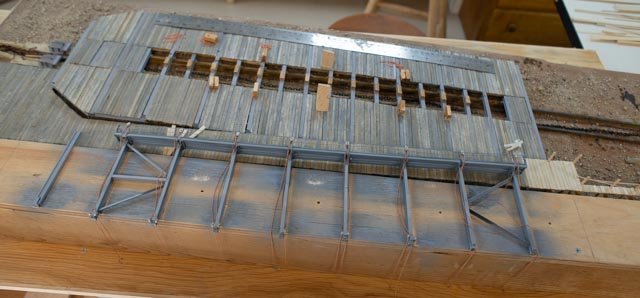 one subtlety in this photo for my record is that the platform I am raising is actually for the other side. Can you believe it!!! I figured it out only minutes after gluing it in place…..I will explain below
one subtlety in this photo for my record is that the platform I am raising is actually for the other side. Can you believe it!!! I figured it out only minutes after gluing it in place…..I will explain below
-
308
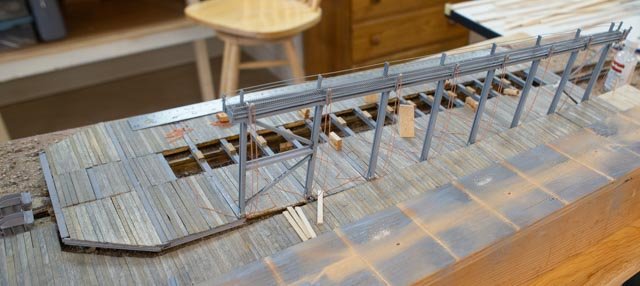 here we are with the ABS welding hopefully going to hold
here we are with the ABS welding hopefully going to hold
-
309
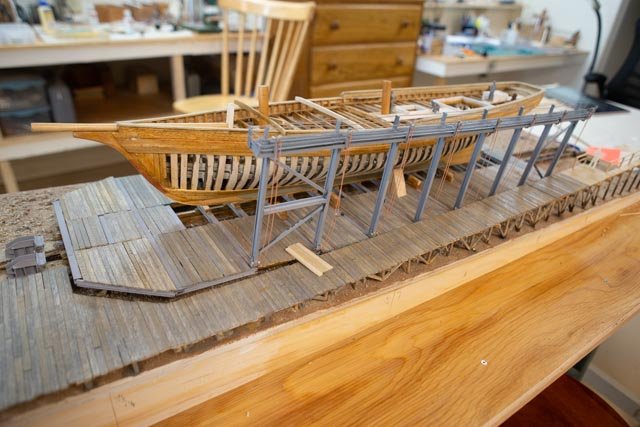 I had to set Ernestina on the railway to see the impact
I had to set Ernestina on the railway to see the impact
Here are three fun views of what is coming along
Now to the next steps of work
-
313
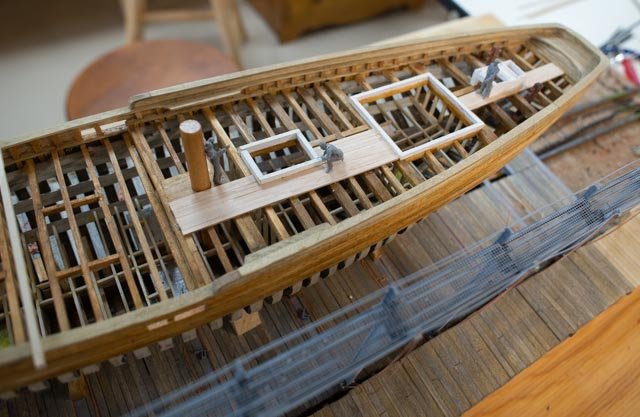 here on deck I have started making 7 figures from an army tank model kit. I shaved off their hats. We’ll see what type scenes to make.
here on deck I have started making 7 figures from an army tank model kit. I shaved off their hats. We’ll see what type scenes to make.
-
314
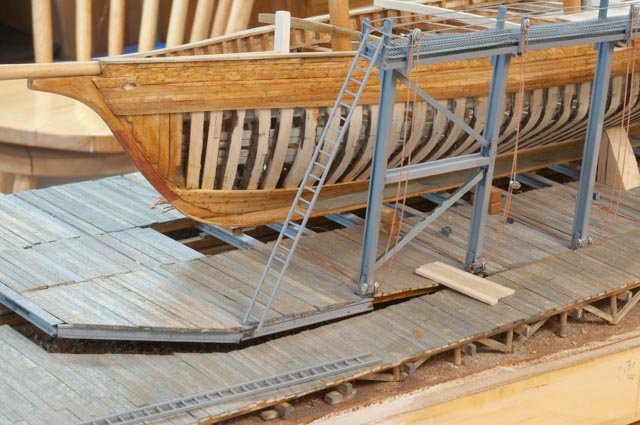 here the access planks are being placed, the ladder was placed only for measurement. The two ladders will be hanged on the dockside of the steel platform columns. Here also for the last time the horizontal steel member in the first bay. It was supposed to be on the water end bay. Oops I mistakenly switched them. so now I must take out this member and place one like it at the far end.
here the access planks are being placed, the ladder was placed only for measurement. The two ladders will be hanged on the dockside of the steel platform columns. Here also for the last time the horizontal steel member in the first bay. It was supposed to be on the water end bay. Oops I mistakenly switched them. so now I must take out this member and place one like it at the far end.
-
315
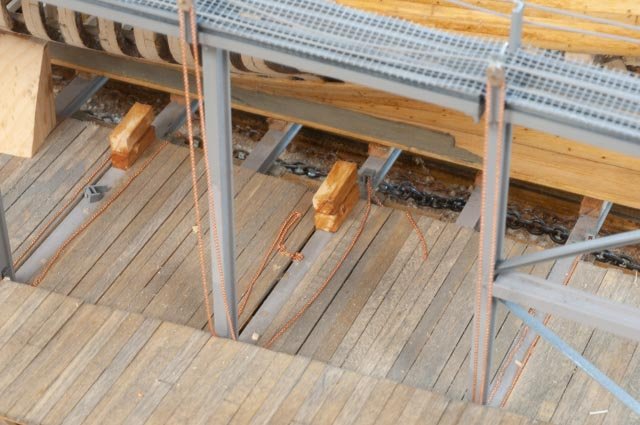 here is an early view of the stand set up with the chains. , the real ones are dirty galvanized. I plan to leave these now as visible copper just make them stand out. One humorous reason is they are the most expensive thing I have had to buy for this build.
here is an early view of the stand set up with the chains. , the real ones are dirty galvanized. I plan to leave these now as visible copper just make them stand out. One humorous reason is they are the most expensive thing I have had to buy for this build.
All for now
-
306
-
Post 29
More detail progress on deck and the dock gets built
The schooner deck is coming along, and the dock is now completely installed and ready for saltwater impacts like tide markings. I am getting ready to install the first steel structure on the railway car.
The schooner
-
296
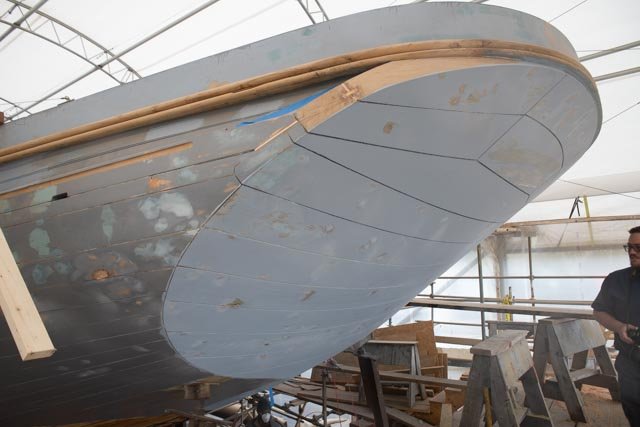 here we see the detail of the planning on the transom.
here we see the detail of the planning on the transom.
-
297
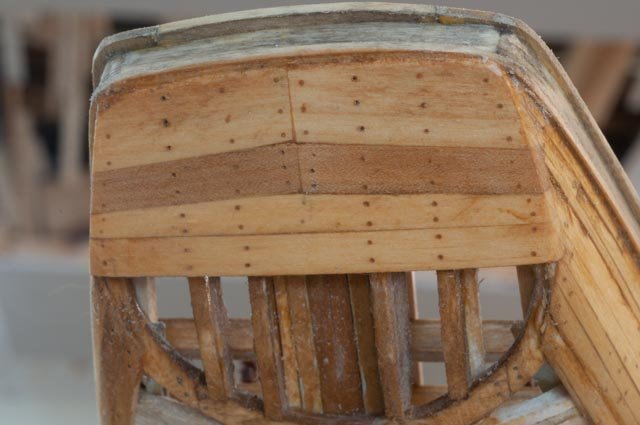 here is my attempt to replicate it
here is my attempt to replicate it
-
298
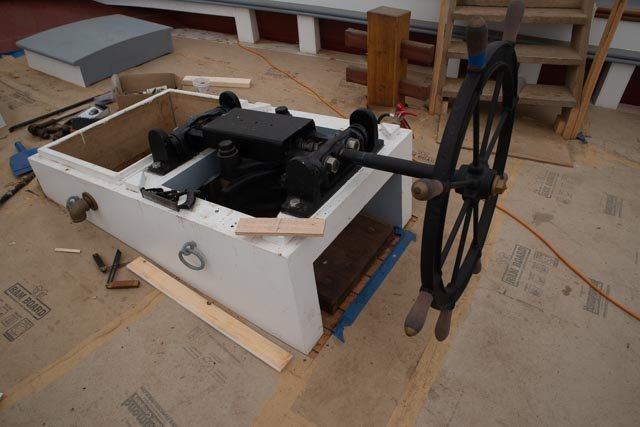 Here is the wheel gear box and access hatch
Here is the wheel gear box and access hatch
-
299
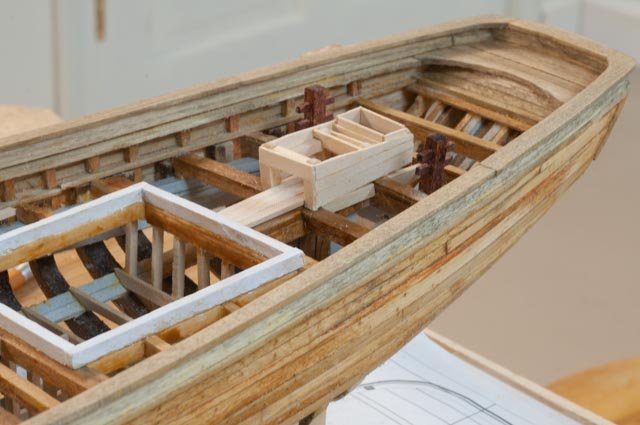 here is my attempt to replicate it
here is my attempt to replicate it
-
300
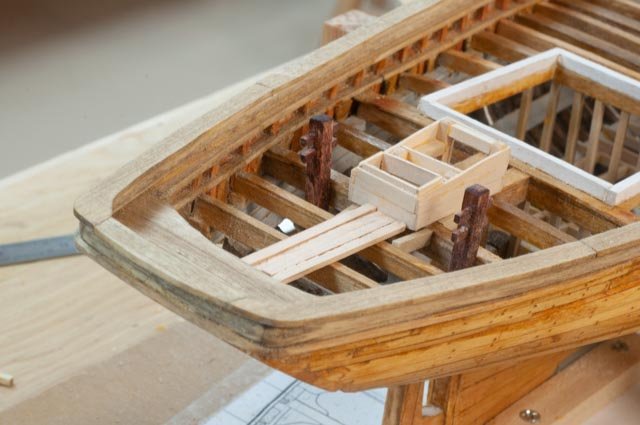 this view from the aft side.
this view from the aft side.
-
301
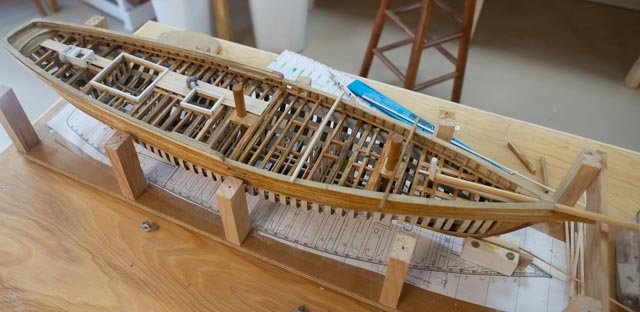 My next question is how, if at all, do I finish the wood. There are various stains and that could be enough. I often used either wipe on poly of tongue oil in the past. Once I do either there is no more ability to fuss with coloring etc. the decking is unfinished maple at the moment, and it needs something just to stay clean and to be cleanable in the future. I also must decide how much deck to install. There is no right answer I believe to that question, so I will see where it goes. I want to complete enough in the bow to show the two lazarette hatches. I need to get the scuppers in soon too.
My next question is how, if at all, do I finish the wood. There are various stains and that could be enough. I often used either wipe on poly of tongue oil in the past. Once I do either there is no more ability to fuss with coloring etc. the decking is unfinished maple at the moment, and it needs something just to stay clean and to be cleanable in the future. I also must decide how much deck to install. There is no right answer I believe to that question, so I will see where it goes. I want to complete enough in the bow to show the two lazarette hatches. I need to get the scuppers in soon too.
The dock
-
302
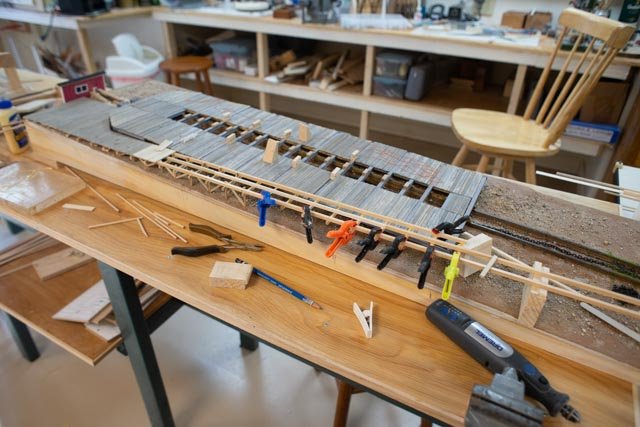 this work on the dock needs to realistic enough to make sense but not take over as to the subject. I hope what I doing here works.
this work on the dock needs to realistic enough to make sense but not take over as to the subject. I hope what I doing here works.
-
303
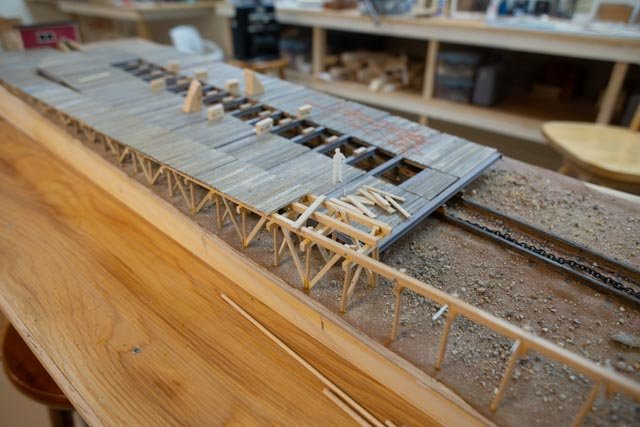 as we move past the railway, the dock does stop for a bay and then continue out into the harbor with another building. I hope the sing sting of piles works.
as we move past the railway, the dock does stop for a bay and then continue out into the harbor with another building. I hope the sing sting of piles works.
-
304
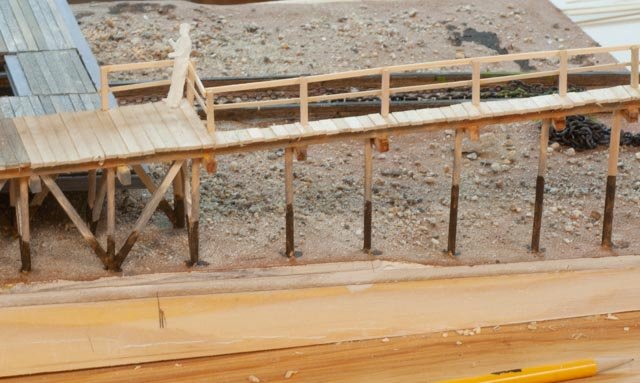 here I started to show the low tide makings on the piles. I also hope the handrail will help explain this line is the end of a dock that makes up the shipyard. We will need to have an over view phot top make that more clear.
here I started to show the low tide makings on the piles. I also hope the handrail will help explain this line is the end of a dock that makes up the shipyard. We will need to have an over view phot top make that more clear.
-
305
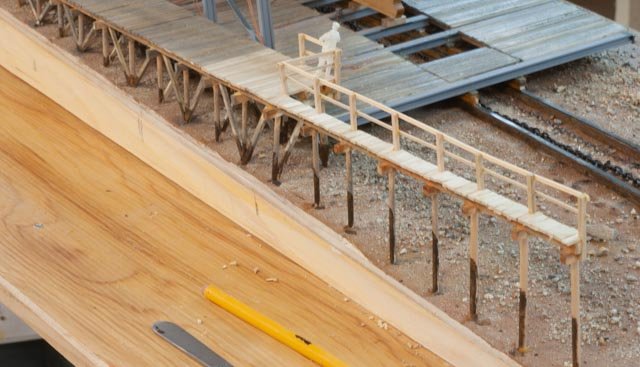 coming up soon I need to get into the seaweed and other things to help make the shoreline more realistic. That is actually fun as I have to invent my way through the stage and hope it all works.
coming up soon I need to get into the seaweed and other things to help make the shoreline more realistic. That is actually fun as I have to invent my way through the stage and hope it all works.
Next up I need to complete the fore deck framing and get into decking. Then I need to set the first steel frame and platform and work on chains.
-
296
-
Post 28
Progress on deck and the engine room hatch rebuild
This post records one of the challenges of building a model without proper drawings. The park service drawings for Ernestina were based on field measurements made in 2008 ish. The 2016 redesign and rebuild has many subtle changes. I am dependent on my observations and photos to pick them up.
Recently I was asked for information regarding the pumps. I posted the photo below on Allanyed's site without much thought, as I am not building out all the deck furnishings. Now that I progressed as far as I have with the framing and deck beams, I started adding deck. I found something that did not make sense.
-
286
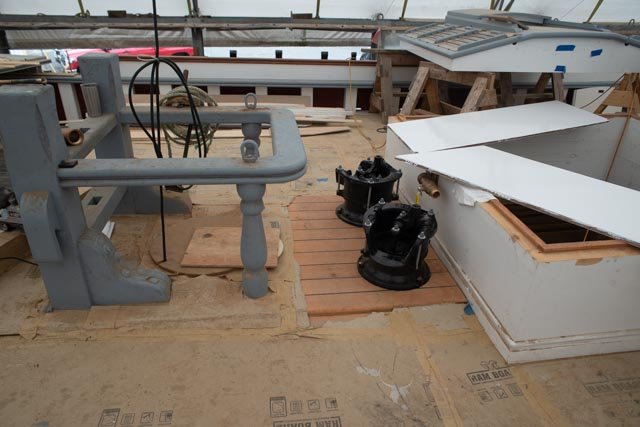 This view shows the new pump on the rebuild in a space between the main fife rail and hold hatch that is clearly as big as the fife rail. Let’s call it 4 feet.
This view shows the new pump on the rebuild in a space between the main fife rail and hold hatch that is clearly as big as the fife rail. Let’s call it 4 feet.
-
287
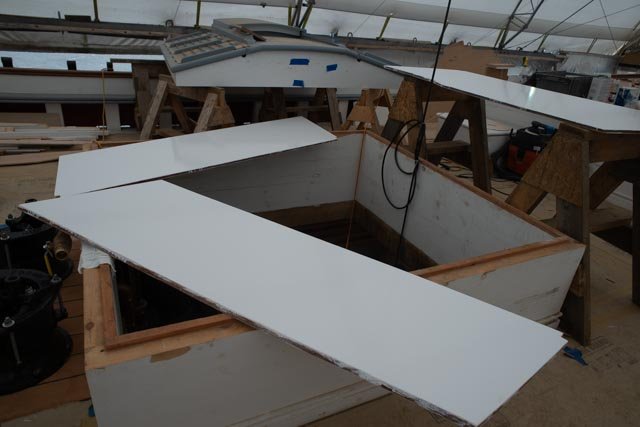 This view shows the engine room hatch/ dog house being almost square.
This view shows the engine room hatch/ dog house being almost square.
-
288
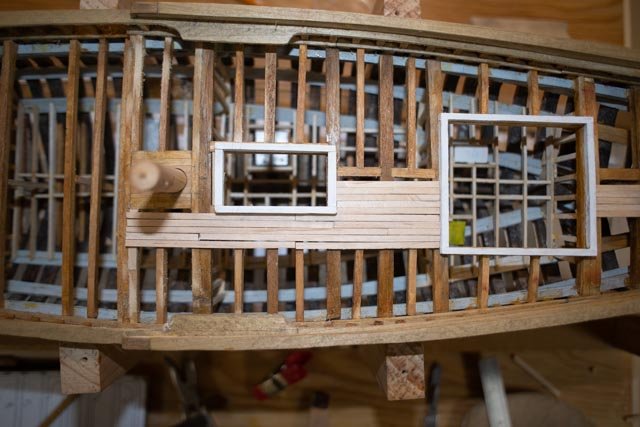 This view shows what I built that clearly reflects the drawings. The hatch is big and comes forward to the major deck beam just aft of the main mast. This configuration may agree with the drawings but clearly not the photos of the new build.
This view shows what I built that clearly reflects the drawings. The hatch is big and comes forward to the major deck beam just aft of the main mast. This configuration may agree with the drawings but clearly not the photos of the new build.
I was lucky to get to the yard and learned that I not only did the hatch wrong, but the lower bulkhead should also be one beam aft of what I built, again as I built to the old drawing. I need now to dismantle and rebuild the hatch and bulkhead. That will also free up space between the major deck beams for the pumps and reflect the new build.
289
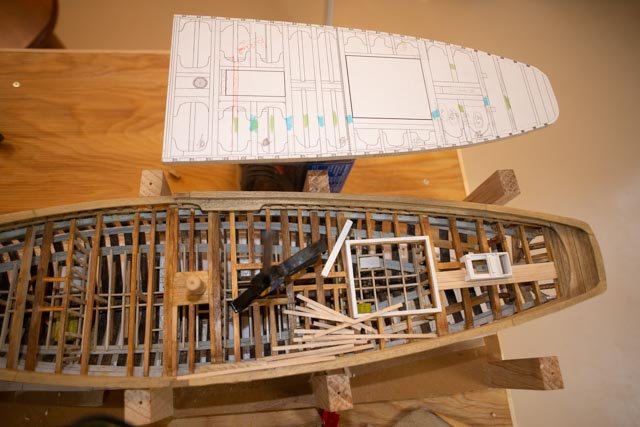 this view shows the deck plan with a red line where the forward extent of the hatch needs to be located The reduced size of the hatch would give room and clearance through the structure for the pump as well.
this view shows the deck plan with a red line where the forward extent of the hatch needs to be located The reduced size of the hatch would give room and clearance through the structure for the pump as well.
-
290
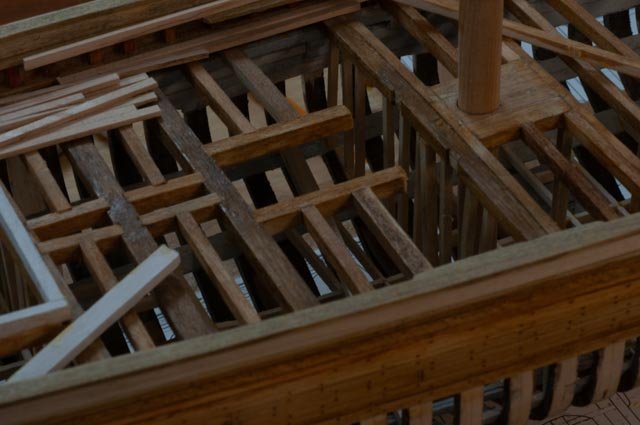 This closeup shows the bulkhead below that needs to be moved aft one frame.
This closeup shows the bulkhead below that needs to be moved aft one frame.
-
291
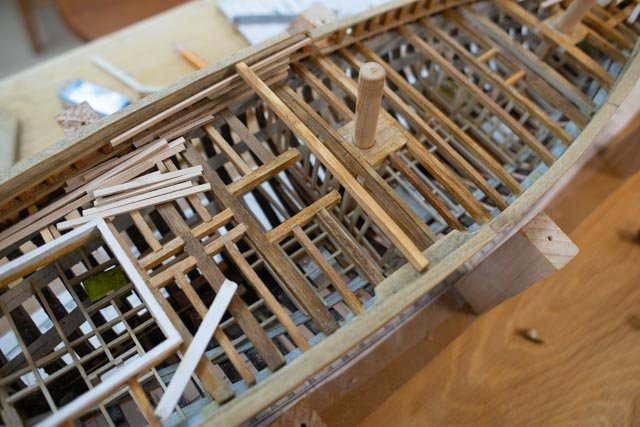 Here I have made a new deck beam.
Here I have made a new deck beam.
-
292
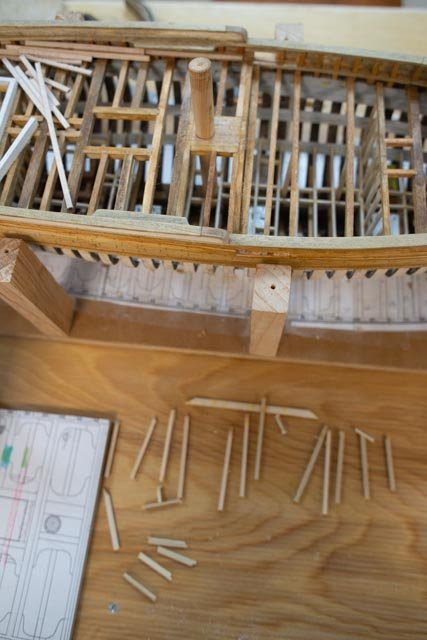 In this view I have removed much of the lower deck frame and bulkhead. I may be able to reuse most of these pieces in the rework.
In this view I have removed much of the lower deck frame and bulkhead. I may be able to reuse most of these pieces in the rework.
-
293
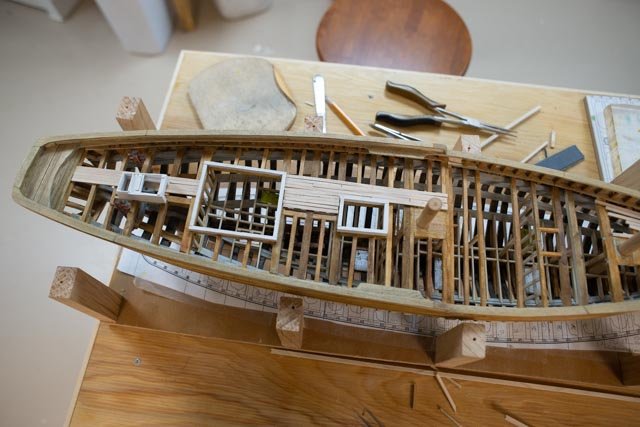 Here we are all rebuilt and the deck recut and placed.
Here we are all rebuilt and the deck recut and placed.
-
294
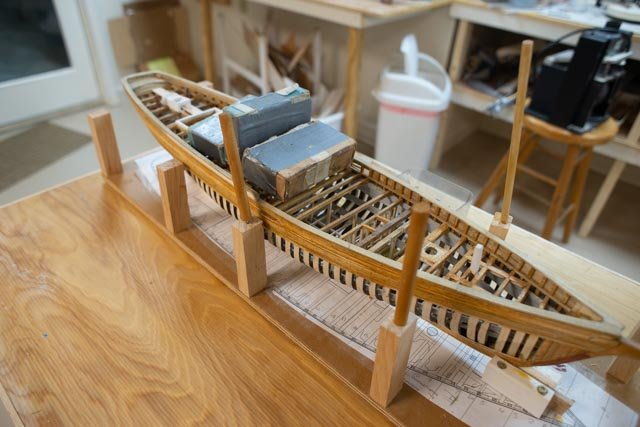 Here we are a few days later where we wanted to be. The decking around the hatch is being glued down.
Here we are a few days later where we wanted to be. The decking around the hatch is being glued down.
-
295
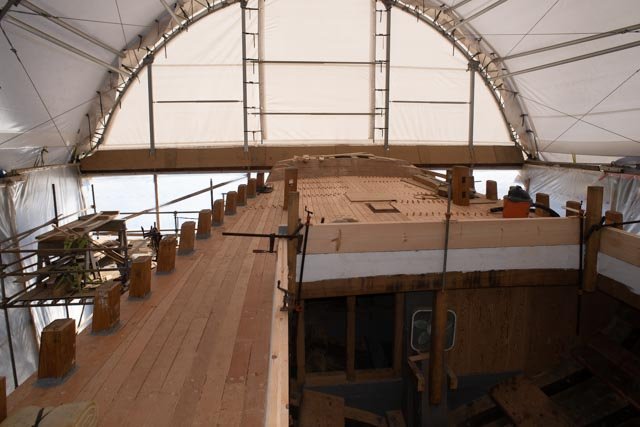 I wanted to share this view of the real hatch construction. The hatch curbs are painted white. The unfinished wood is the buildup of the doghouse that as of now I am not building. I may rethink this later.
I wanted to share this view of the real hatch construction. The hatch curbs are painted white. The unfinished wood is the buildup of the doghouse that as of now I am not building. I may rethink this later.
Well, I lost some time. Checking things twice pays off. Fortunately the rework was not too taxing.
All for now
-
286
-
Post 27
Diorama update on the dock and boat stands
This posting records progress on the railway. I also want to share some more images of what the real equipment looks like and then my approach to replicate it in miniature. There is also a sequence issue that I will share below. What I want the observer to learn from seeing the diorama is how the railway works. First up is some progress.
-
273
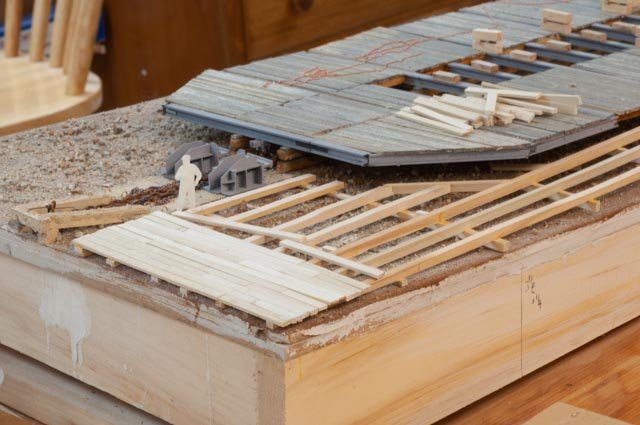 in this view the building of the structural steel towers has progressed to painting and has gone from the table. I have started the dock.
in this view the building of the structural steel towers has progressed to painting and has gone from the table. I have started the dock.
-
274
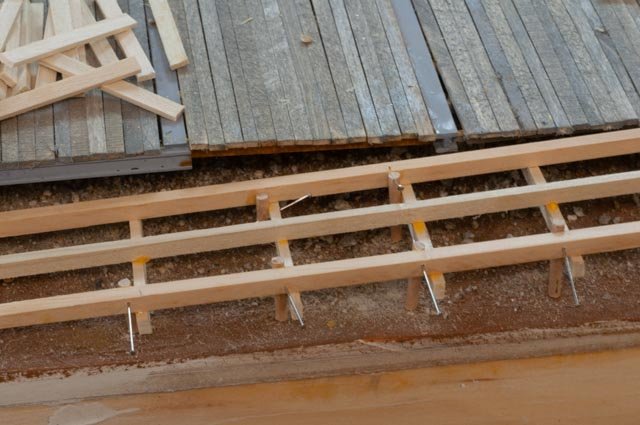 as we start building the dock toward the harbor, the railway car deck is 2-3 feet above the dock. The piling starts somewhere under here.
as we start building the dock toward the harbor, the railway car deck is 2-3 feet above the dock. The piling starts somewhere under here.
-
275
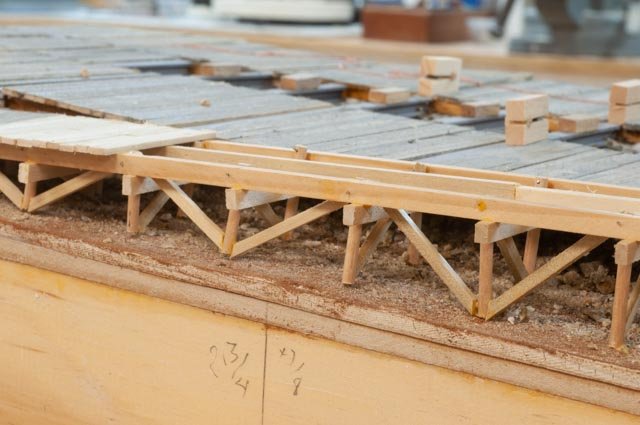 as I work south, I need to make the piling reasonably realistic as one can see through from the side. I can promise this task is another rabbit hole.
as I work south, I need to make the piling reasonably realistic as one can see through from the side. I can promise this task is another rabbit hole.
-
276a
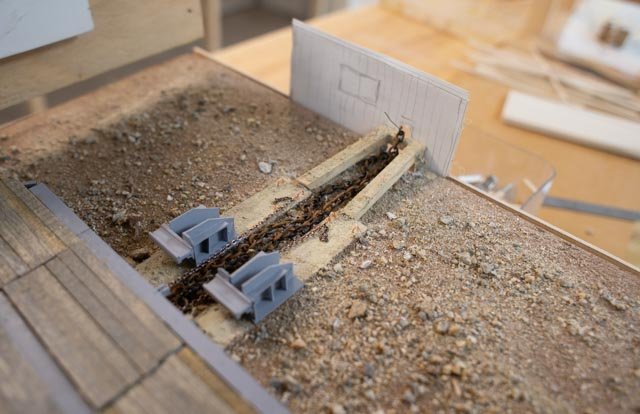 at the top end I need to both close in the ugly side of the diorama for paint out and thought it would be good to show the front of the winch hose that pulls the chain.
at the top end I need to both close in the ugly side of the diorama for paint out and thought it would be good to show the front of the winch hose that pulls the chain.
-
276 b
 here is an image of the scene. The large 10-inch chain goes in and out around a windlass to pull the car either way.
here is an image of the scene. The large 10-inch chain goes in and out around a windlass to pull the car either way.
-
276 c
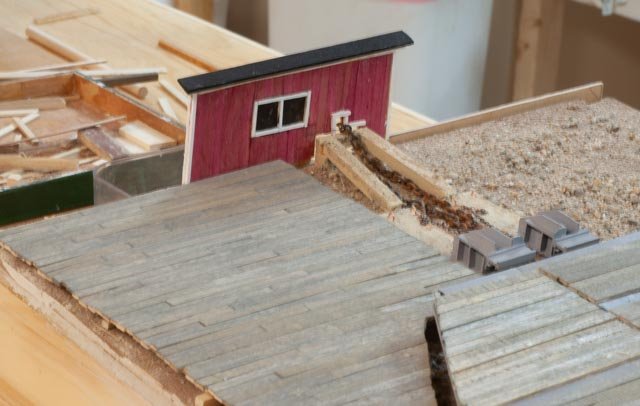 here we are with siding etc. I will add the sign
here we are with siding etc. I will add the sign
Ship stands are quite unique, and I want to represent them the best I can. The phasing issue is that while frames and exterior planking is underway, these stands are not in place. They go in after planking. I feel though the system is important, and I will explain it below.
-
277
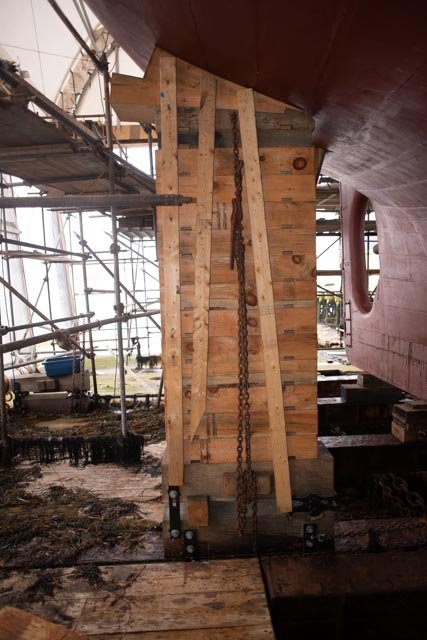 here is a complete stand. In this build there are ten of them engaged. The system allows for 8, a pair at each of the main columns in the structural.
here is a complete stand. In this build there are ten of them engaged. The system allows for 8, a pair at each of the main columns in the structural.
-
278
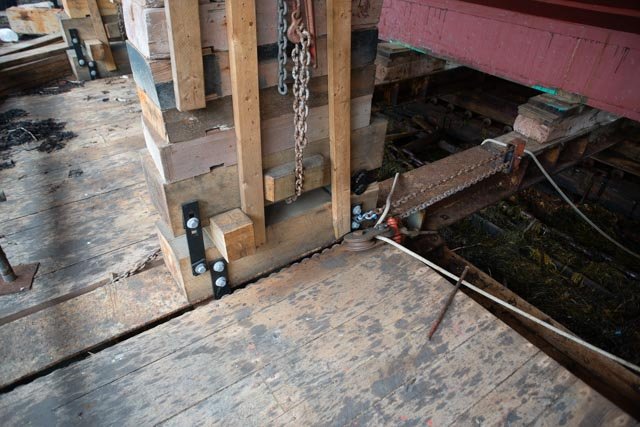 here you can see the tabs that ride on the edge of the floor plank. The forward uphill stand connected to a chain that passes through the box sheave and runs on the near side of the beam across the car to the exterior. the chain on the far side of the beam connect to the outer corner of the block. These chains pull either toward or away from the ship [ schooner tug or other vessel when the car is in the harbor to either grab a vessel when hauling or loosen a vessel at launch.
here you can see the tabs that ride on the edge of the floor plank. The forward uphill stand connected to a chain that passes through the box sheave and runs on the near side of the beam across the car to the exterior. the chain on the far side of the beam connect to the outer corner of the block. These chains pull either toward or away from the ship [ schooner tug or other vessel when the car is in the harbor to either grab a vessel when hauling or loosen a vessel at launch.
-
279
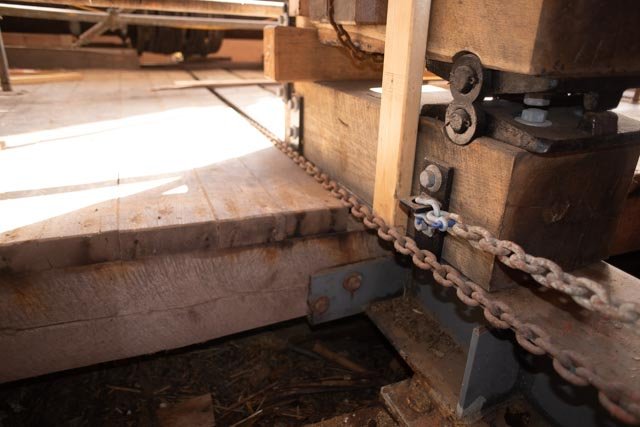 here is a better view of the chain that pulls the stand inward.
here is a better view of the chain that pulls the stand inward.
-
280
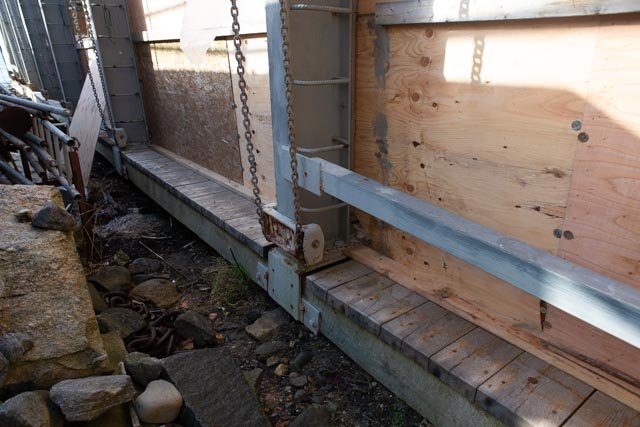 on the outer edge of the car, the continuous chain feeds through two more blocks and upward to the platform.
on the outer edge of the car, the continuous chain feeds through two more blocks and upward to the platform.
-
281
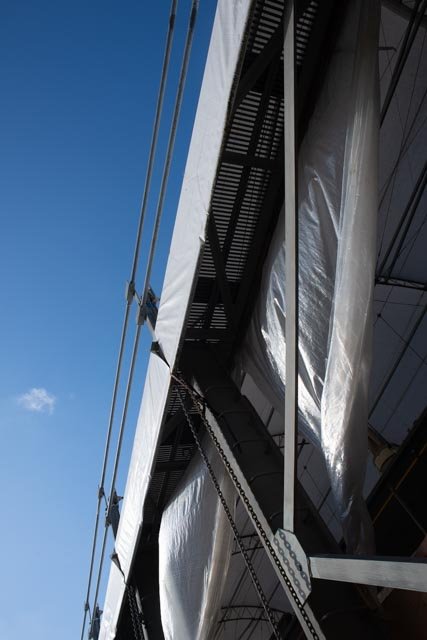 on the platform there is chain fall rig that grabs the chain and with a handle, when operated, allows a man to move the stands in or out accordingly.
on the platform there is chain fall rig that grabs the chain and with a handle, when operated, allows a man to move the stands in or out accordingly.
-
282
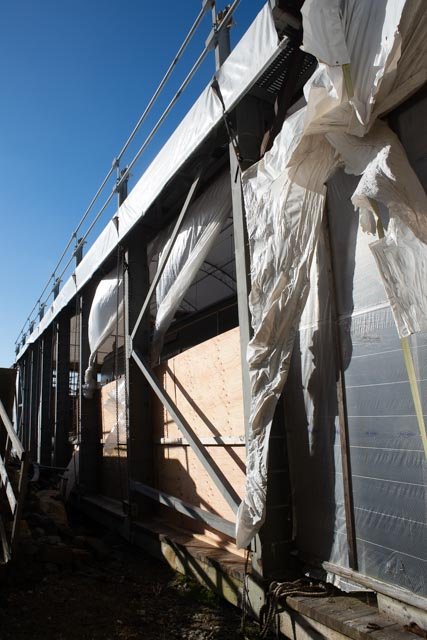 in this view one can see that all 8 columns are set up this way.
in this view one can see that all 8 columns are set up this way.
Now how to model this system …another rabbit hole. To do all eight that means 16 times 20 inches of chain. 64 blocks and attachment to ABS plastic steel. No soldering. I will go as far as I can reasonably…. we’ll see. I started by buying 20 feet of chain and raiding the last of alloy blocks from my Bluejacket stores. I will do at least the 5 engaged stands …again we will see what that looks like
-
283
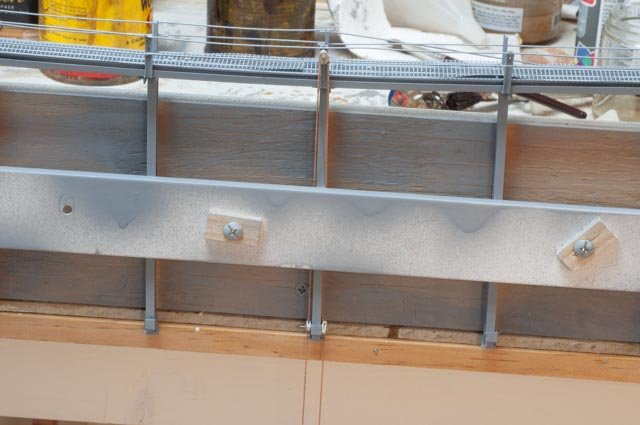 here we see the second side of structure just back from painting. I figured out how to do three blocks attached to ABS and thread the tiny chain.
here we see the second side of structure just back from painting. I figured out how to do three blocks attached to ABS and thread the tiny chain.
-
284
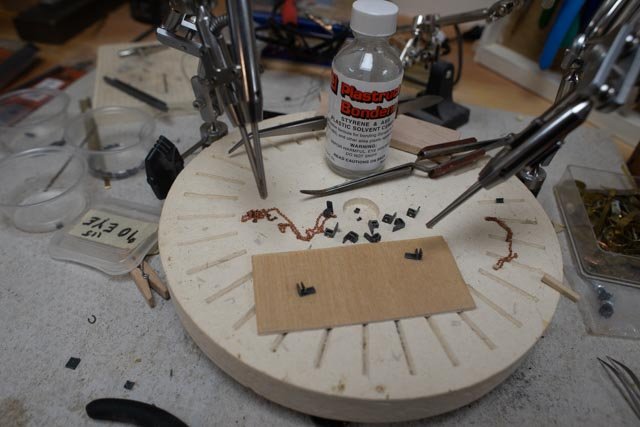 here I am trying to make the blocks to go at the car level out of ABS plastic so I can weld them in place.
here I am trying to make the blocks to go at the car level out of ABS plastic so I can weld them in place.
-
284
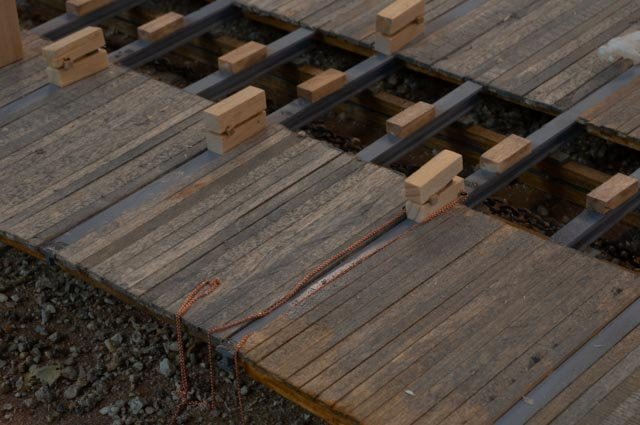 here I have placed the bottom component of the stand where they go and laid out a 20-inch section of chain. The only way I can see to attach 42 link chain is glue. I made an eye that clearly too big so more work there.
here I have placed the bottom component of the stand where they go and laid out a 20-inch section of chain. The only way I can see to attach 42 link chain is glue. I made an eye that clearly too big so more work there.
I think it is important to tell a s tory about this 700ton-railway car. It has been here in some form since 1869. The history of the railway is being studied for exhibition by the yard and that is exciting too.
I probably should make one stand at a 1:12 scale as part of a side exhibit. More to think about.
All for now
-
273
-
Post 26
Progress on top rails and deck level
I am celebrating another small milestone this week. I completed the cap rails yippee.
-
262
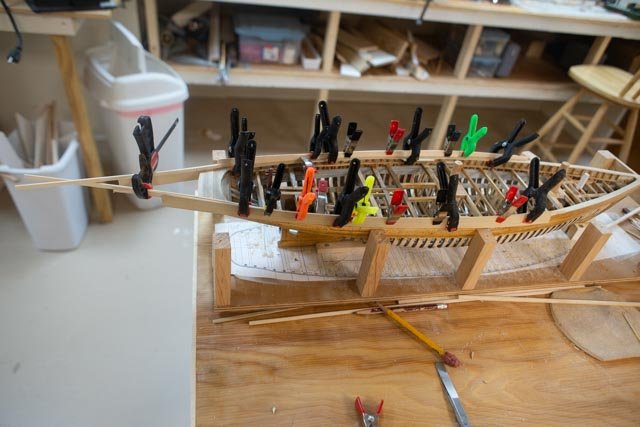 Here we are gluing in the outer band of the monkey rail. I had some scrap 1/32” on the outside resting above the lower cap rail to maintain the right shape and recess…. The outer edge of the two rails match up.
Here we are gluing in the outer band of the monkey rail. I had some scrap 1/32” on the outside resting above the lower cap rail to maintain the right shape and recess…. The outer edge of the two rails match up.
-
263
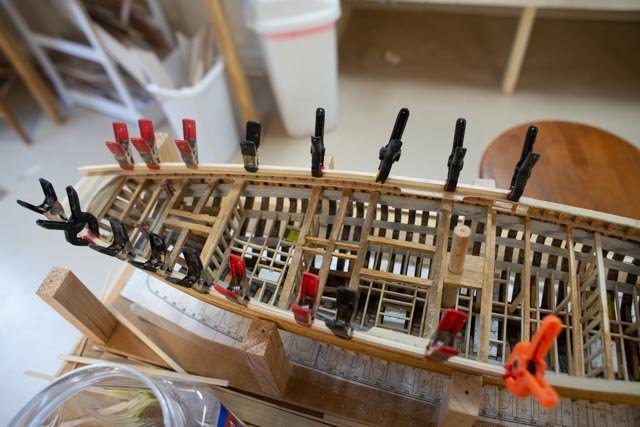 here we are gluing in the inner band of the monkey rail. Two each 1/16” bands give us the 6 inch in scale rail.
here we are gluing in the inner band of the monkey rail. Two each 1/16” bands give us the 6 inch in scale rail.
-
264
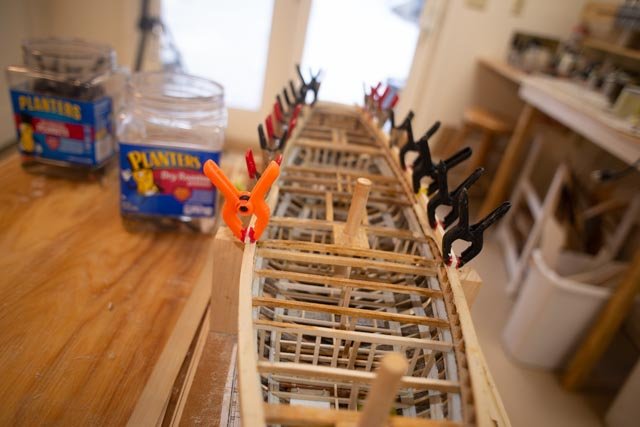 looking better. Now to do the cap rail. It is narrower but more difficult as it rounds to the main cap rail.
looking better. Now to do the cap rail. It is narrower but more difficult as it rounds to the main cap rail.
-
265
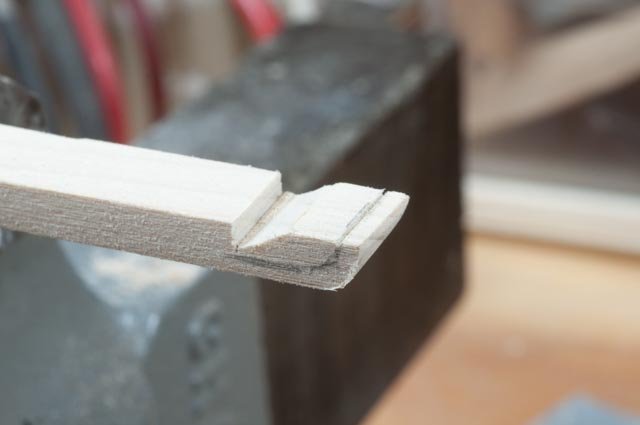 here I took a piece of maple and started carving. it is a true trial and error approach for me.
here I took a piece of maple and started carving. it is a true trial and error approach for me.
-
266
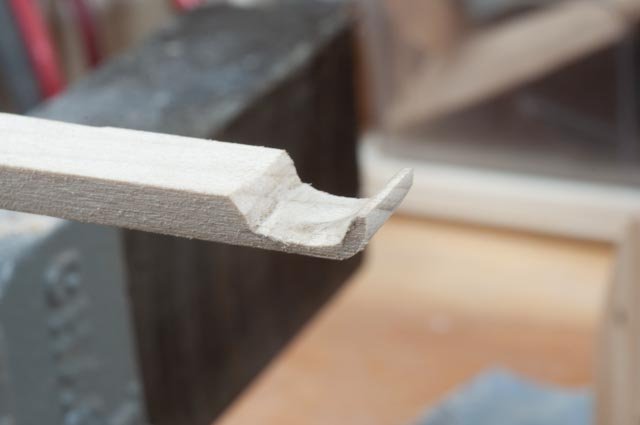 here we are carved, and it is time to split it on the table saw for two pieces.
here we are carved, and it is time to split it on the table saw for two pieces.
-
267
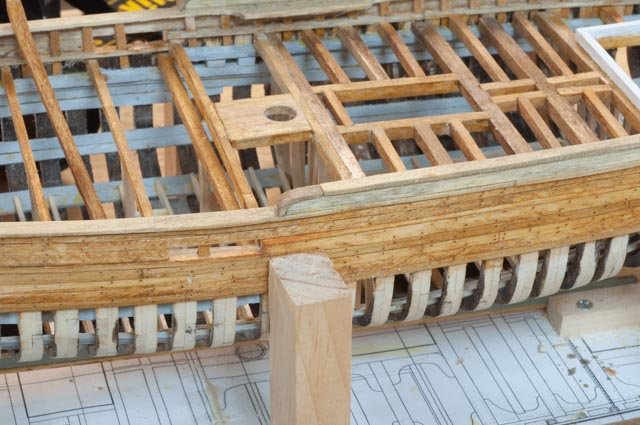 here is the port side from the outside.
here is the port side from the outside.
-
268
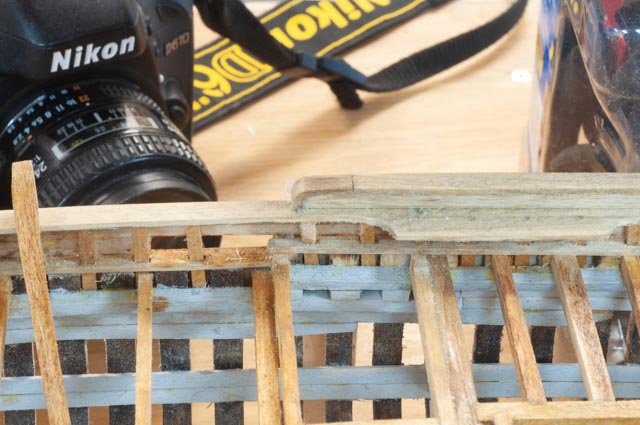 here is the starboard side from inside
here is the starboard side from inside
Now what comes next and what needs more thought
-
269
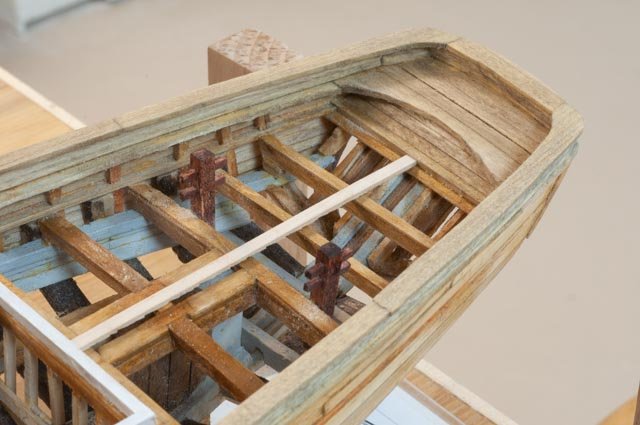 in this view of the stern, I have placed a king plank. I plan to use maple for planking just to have some visual difference. Before I decide where to put decking, I need to build up curbs for the hatches, and things that interrupt the decking. I stared with the captain cabin and am now working my way around. I used a duller cherry stain only on the bulwarks again to show they are different wood. They are all Douglas fir as I understand it. So is the deck but it gets a very dark treatment eventually
in this view of the stern, I have placed a king plank. I plan to use maple for planking just to have some visual difference. Before I decide where to put decking, I need to build up curbs for the hatches, and things that interrupt the decking. I stared with the captain cabin and am now working my way around. I used a duller cherry stain only on the bulwarks again to show they are different wood. They are all Douglas fir as I understand it. So is the deck but it gets a very dark treatment eventually
-
270
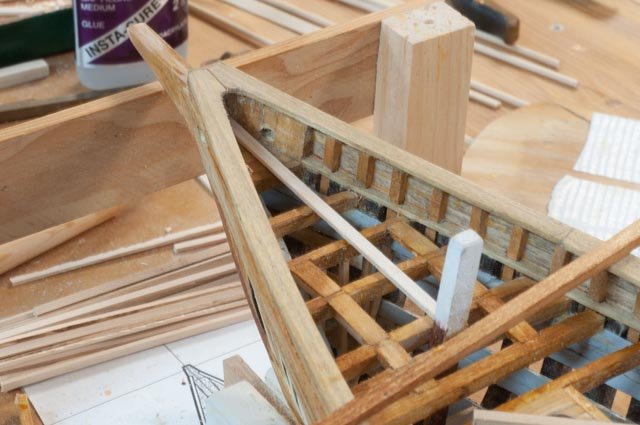 here we see the bow section. I have drilled the hawse holes and set up for the bow sprit. There is a king plank sitting there but ai am unlikely to use. The old drawings show no king plank and the photos I have show none. I am just used to them. the phot of the new deck clearly shows the stern to have none. Also, two planks in the middle fit nicely against he Sampson post. Sounds like a tail wagging the dog but something will be done. if i mount the prop bowsprit no-one can tell anyway.
here we see the bow section. I have drilled the hawse holes and set up for the bow sprit. There is a king plank sitting there but ai am unlikely to use. The old drawings show no king plank and the photos I have show none. I am just used to them. the phot of the new deck clearly shows the stern to have none. Also, two planks in the middle fit nicely against he Sampson post. Sounds like a tail wagging the dog but something will be done. if i mount the prop bowsprit no-one can tell anyway.
-
271
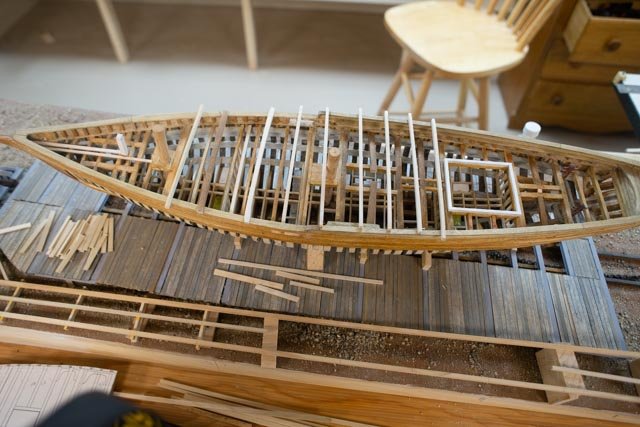 this shot was last Friday just laying out my supply of beams to see if I was ready to attack the main deck. I also had just installed the last few lower deck beams so that area is complete less construction planking and ladders. there is progress below on the dock as well.
this shot was last Friday just laying out my supply of beams to see if I was ready to attack the main deck. I also had just installed the last few lower deck beams so that area is complete less construction planking and ladders. there is progress below on the dock as well.
-
272
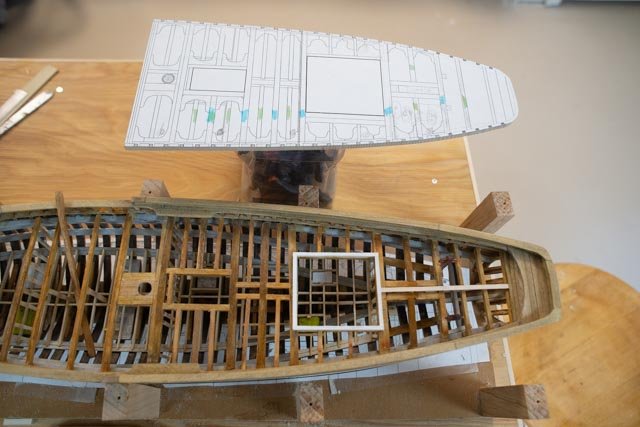 this is todays celebration. Other than the steering gear rig, which is in fabrication, the after-deck framing is complete. I have cut out the curbs [ kerbs] for the next hatch and they are in for painting white like the captain’s cabin curb. The plan above shows I have used the 2006 measured drawings as the basis. The were no noticeable differences going through the current rebuild so we should be OK.
this is todays celebration. Other than the steering gear rig, which is in fabrication, the after-deck framing is complete. I have cut out the curbs [ kerbs] for the next hatch and they are in for painting white like the captain’s cabin curb. The plan above shows I have used the 2006 measured drawings as the basis. The were no noticeable differences going through the current rebuild so we should be OK.
Next up I will continue forward on the deck frame and building of the diorama dock
cheers
-
262
-
Allan
I just found this posting, so I understand you email
I will post photos on how down hauls are tied off on my Bluenose log. I am restarting that to complete sails and that will include gaff down hauls
Main gaff has both p and s going to the rails
Fore gaff drops straight down to starboard fife rail
Cheers
- allanyed, mtaylor and thibaultron
-
 3
3
-
This posting is to record the progress as I pick up this build and carry it to completion.
When I left this work in august 2018 the model got to travel around on pillows in the back of a pickup to two showings. We since have gained an open yard trailer that lets her lay flat and go under cover if need be. She was moved in November 2020 to this new house and has patiently waited for her star to rise again. My Daughter came for Christmas as Covid-19 has truly limited mobility. She was here for a work week and play week. Can you imagine…go to the coast of Maine and work through your computer as if you are still somewhere else.
Anyway, the point is we decided to start the process to complete three upper sails and to replace the main sail and jumbo. Their replacement needs were well documented earlier in this build log and the question was both motive and time. My daughter took on the job to take the old mainsail and replicate it. Then she added the in-scale bolt rope and helped in any other ways. I started to commit a few hours a week away from my other build to plug along.
Today, I like many others have enjoyed getting into an exchange with other Schooner lovers about how certain lines are made off. As this build records, I made two trips to Lunenburg and took oodles of photos in high definition, so that I can blow them up and check many things out. So, I answered the specific question but choose to document here the findings as I too want to have those lines included on Bluenose. I recommend anyone reading this log to jump over to the build of the Effie Morrissey 1898 by Allanyed. In doing so, you will find a beautiful schooner being rigged for fishing at the same time. She fished from 1898 to 1925 mostly out of Canada with that rig which is contemporary with Bluenose
Therefore, for the record, I resumed work Christmas week 2020 to complete sails and running rigging hopefully by summer.
-
1101
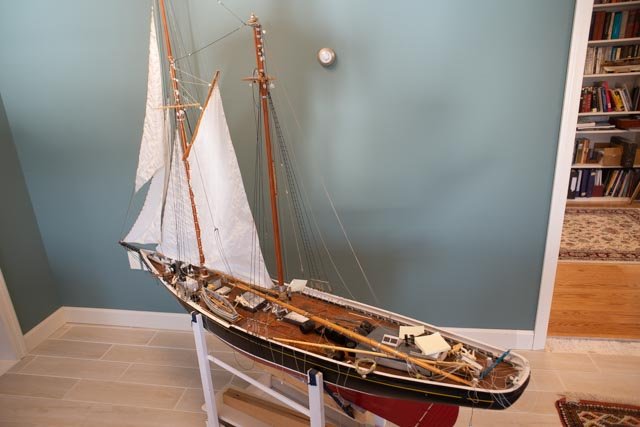 here she sits in her new home missing the old mainsail. If you look closely the main top mast is off too. While she sewed the new sail, I was in the shop making more hoops.
here she sits in her new home missing the old mainsail. If you look closely the main top mast is off too. While she sewed the new sail, I was in the shop making more hoops.
-
1102
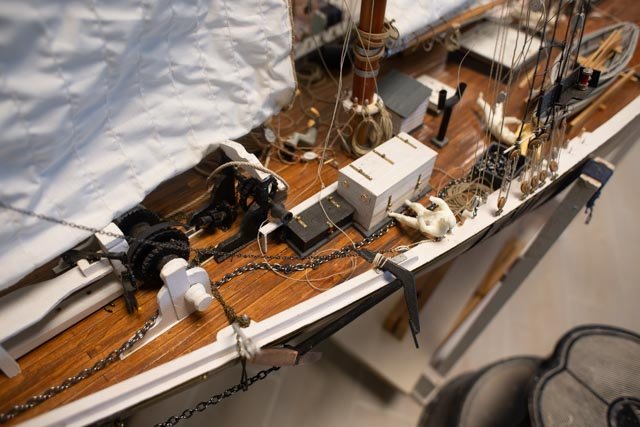 here if one looks closely there are broken parts on the windless and probably missing pieces from the moves
here if one looks closely there are broken parts on the windless and probably missing pieces from the moves
-
1103
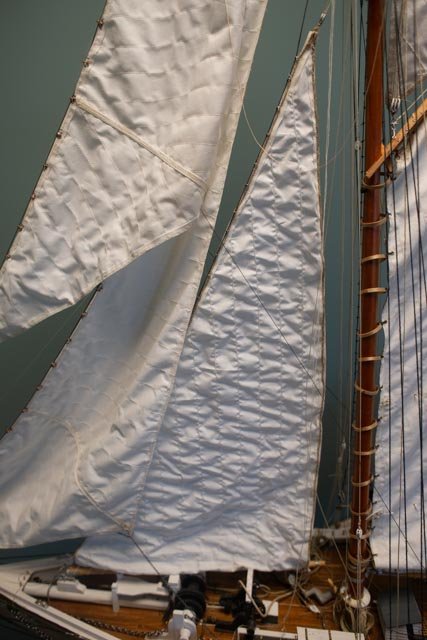 here we see the old jumbo. It is the only remaining sail. As for most of us, if we make one or two of something and then compare it a to the third and forth made a few years later, there is likely a need to rework or to replace the older version. We will see when we get to that sail. First to the others
here we see the old jumbo. It is the only remaining sail. As for most of us, if we make one or two of something and then compare it a to the third and forth made a few years later, there is likely a need to rework or to replace the older version. We will see when we get to that sail. First to the others
I had made up the three topsails in 2017 and pinned them to the model while on display as seen in photos above
-
1104
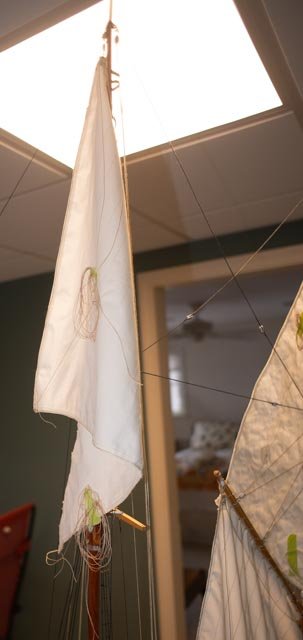 here the main topsail is in place. The tack lines and clewline are sewn in and coiled, ready for rigging after the mainsail is set
here the main topsail is in place. The tack lines and clewline are sewn in and coiled, ready for rigging after the mainsail is set
-
1105
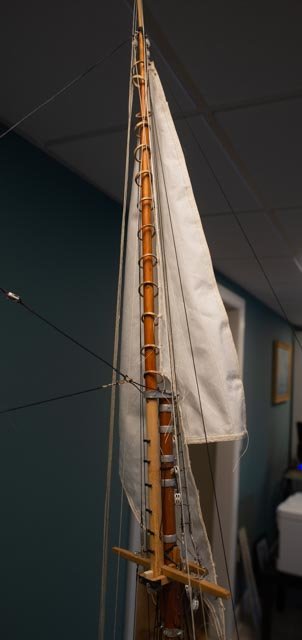 here the hoops are sewn to the sail. I had to add three hoops to get the number right…a lot of extra trouble. I can’t remember how I missed that before I fixed that mast.
here the hoops are sewn to the sail. I had to add three hoops to get the number right…a lot of extra trouble. I can’t remember how I missed that before I fixed that mast.
-
1106
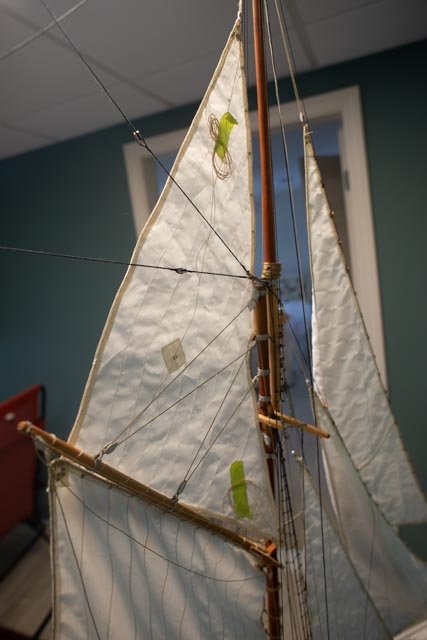 yesterday I finished adding lines and hoisted the fore topsail. Next week the hoops get sewn.
yesterday I finished adding lines and hoisted the fore topsail. Next week the hoops get sewn.
I am working Sundays on this project so it will take some time. also there is no running rigging or sails on my other current build, so this work is refreshing. I did some research on the gaff down hauls and will post that next time. I believe the clewlines act as the down haul for these two top sails. And the jibs are all in as well. That leaves the two gaffs to rig, so as I attach the top sail sheets, I will need to splice in the down hauls to the ends of the gaffs.
All for now
- allanyed, KeithAug and GrandpaPhil
-
 3
3
-
1101
-
Allan
no sail plans yet for EM. One more detail I suspect is there were more connections in the stern. I again take my learning from Bowdoin arctic rigging and Bluenose with its large size. There were quarter tackles to secure the boom, the topmast backstays were made aft for the upwind side and last pin behind dory tackle on the main mast for leeward side. There were down hauls on the main gaff peak tied off to Starboard. Also several lines both on the rails and the fife rails needed snatch blocks on deck to allow a few men to grab the line and pull and then take it to a pin to tie it off. We learned that while sailing on Bluenose. I believe there is no need for all the travelers on Effie though. For sails like the fisherman's staysail, they were flown from the deck per tack. the tack lines and all add up to more pins. The halyard was continuous and that means two more pins and deck block. Main and fore halyards were continuous as well. I only made the pin rail according to the drawing. if i were going to fly sail I would add several pins. I would move flag halyards to the shrouds etc. like on a ship. i wish you the best in the challenge.
I am grateful for the park service drawings but remind us all that they are measured drawings made after many tough years of packet service and ultimate return to US in sorry shape. I agree with you and other commenters above that Chappelle and other Gloucester/ Essex Schooner info is the best source.
I typed this much because it is 18 degrees outside.
cheers
-
thanks John
Allan
here is the buffer. I am very happy you are doing it. I am modeling pre paint, so I think home free without deck furniture. the railway is definitely adding more scope though. I went back up on deck to see if they have a horse. that would mean to my understanding that after back and forth to the buffer they come down to a horse to feed the port side bitt. I did not find one. To be fair to the yard, they are still waiting on the rigging design. new masts etc.
also my visits need to be delayed a bit.
cheers
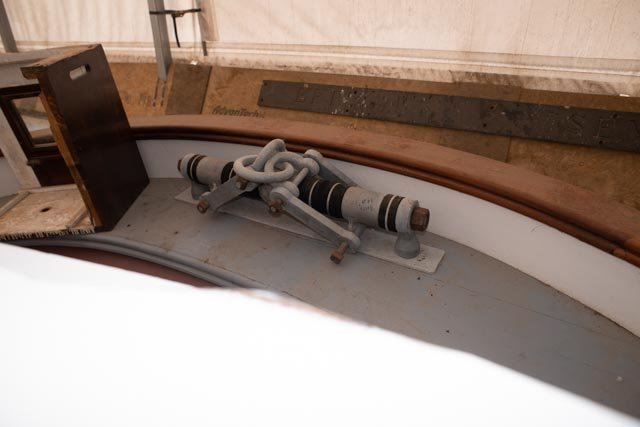
-
Allan
i love your work...so clean and crisp.
I am just catching up on this saga of pins and cleats on the boom. It may be a stretch, but I learned a lot when I researched Bluenose for my build. I went to Lunenburg twice, spoke with the captain, sailed on her etc. He pointed out things of difference on Canadian schooners, but they did not include this subject.
There is a great resource I bought while there, The measured drawings on Bluenose LL by L B Jensen. He had taken, as I understand, information from the original 1921 as a basis. Also, there are numerous photos of the original online that I used. The Captain told me running rigging has not changed other than material upgrades.
The book of drawings clarify as follows:
- Pins in the yoke of the main boom clearer take both the Boom Tackle [ guy] on the starboard side and topping lift on the port side.
- As to the ring forward and below the boom….if I understand correctly....The yoke rides on what I unknowingly call a table or boom seat. Below the table are two bands with forward attachment of a small winch. I assume [ guessing] it was for using the halyard whips to snug up sails. The new Bluenose II , which is actually Bluenose III as like Ernestina she was completely rebuilt again about 10 years ago, has nothing below the “table…boom seat”. Another possibility was to place a snatch block there instead of on the deck for taking halyards or whips. We need to remember there is, nor ever was, a motorized winch to raise those heavy sails.
- Flag halyards on the Bluenose drawings are pinned to the forward most end of the port and starboard pin rails. One on either side [ two more needed pins.]
One of my concerns looking at the Ernestina park service drawings is the lack of pins on the rails. There are more lines than pins for complete running rigging, dory tackle etc. and no place to put them. Good luck .
jon
-
Post 25
How to finish the outside
Now the cap rail is going on, I need to figure out the final finish for the exterior planking vs. frames etc. First up, let’s get that cap rail done.
-
251
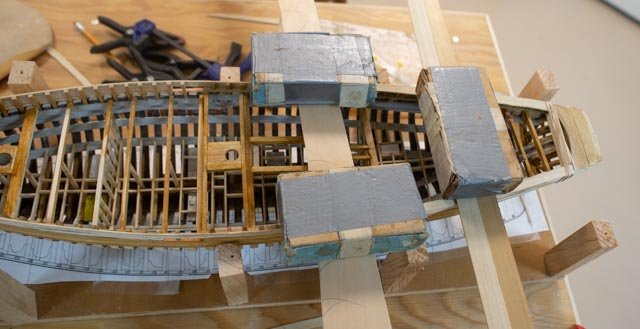 I continue to use milled poplar for this build. The rail is marked and cut out of ¾ inch strips
I continue to use milled poplar for this build. The rail is marked and cut out of ¾ inch strips
-
252
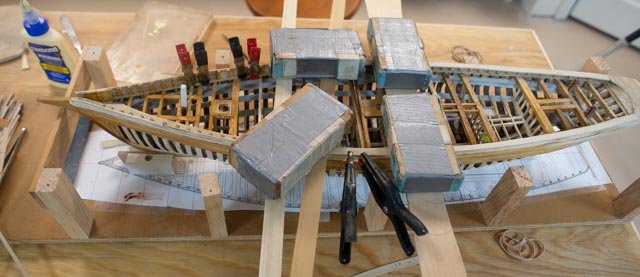 The mid-section includes the pin rail for the main mast.
The mid-section includes the pin rail for the main mast.
-
253
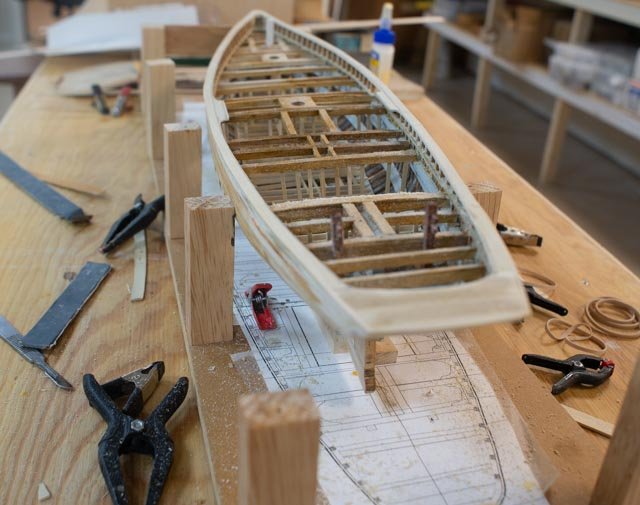 here all rail sections are on and ready for shaping. I used this process also to build out the fan tail.
here all rail sections are on and ready for shaping. I used this process also to build out the fan tail.
-
254
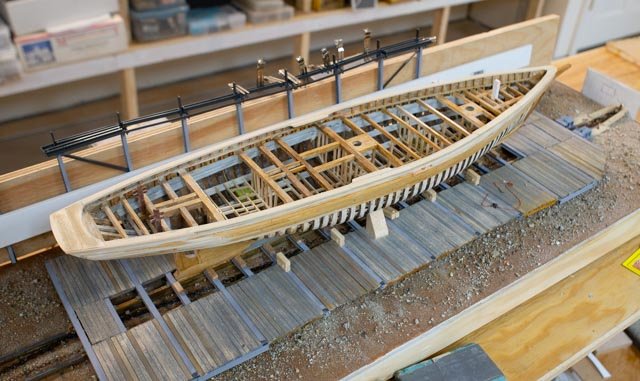 at this point, I feel we are starting to look like a schooner. The rail makes so much difference.
at this point, I feel we are starting to look like a schooner. The rail makes so much difference.
Now how to finish, and what to show
-
255
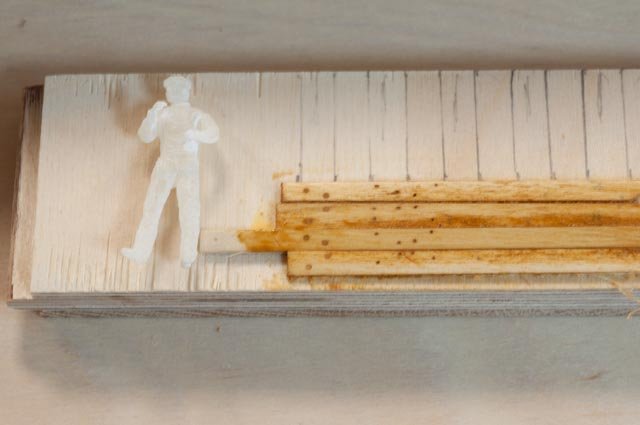 here I tested an attempt to drill and plug holes for trunnions on the left column. No good and too big and way too much work for the result. The second frame to the right is simple, smaller holes drilled and rubbed over with stain to fill the holes. Some sawdust was included. This is the way for me and now let’s get it on.
here I tested an attempt to drill and plug holes for trunnions on the left column. No good and too big and way too much work for the result. The second frame to the right is simple, smaller holes drilled and rubbed over with stain to fill the holes. Some sawdust was included. This is the way for me and now let’s get it on.
-
256
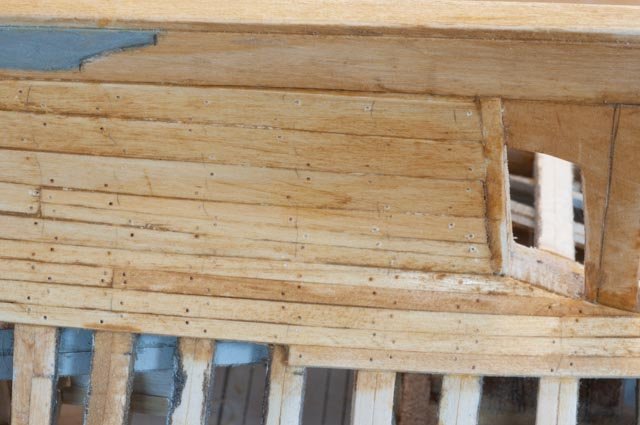 on this attempt of the lower planks, I tried applying shellac to better fill up the holes.
on this attempt of the lower planks, I tried applying shellac to better fill up the holes.
-
257
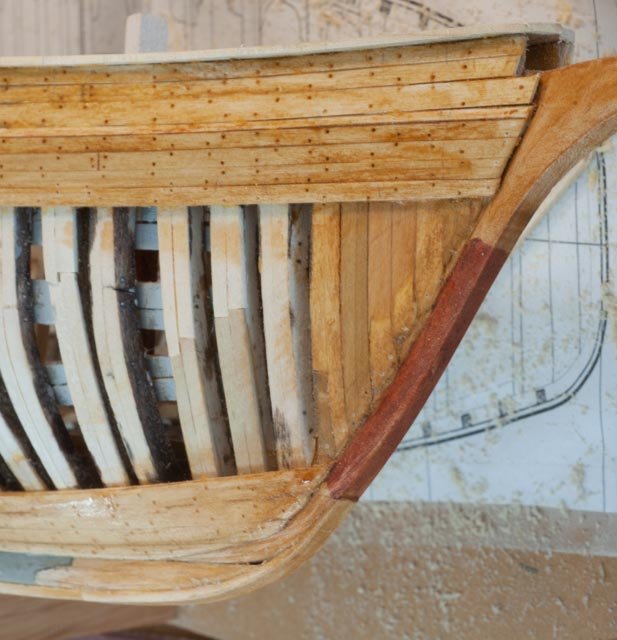 in this view I only used the golden stain and I like the results more. It is a subtle indication of trunnels. I was lucky to have earlier images, previously posted, showing the pattern.
in this view I only used the golden stain and I like the results more. It is a subtle indication of trunnels. I was lucky to have earlier images, previously posted, showing the pattern.
-
258
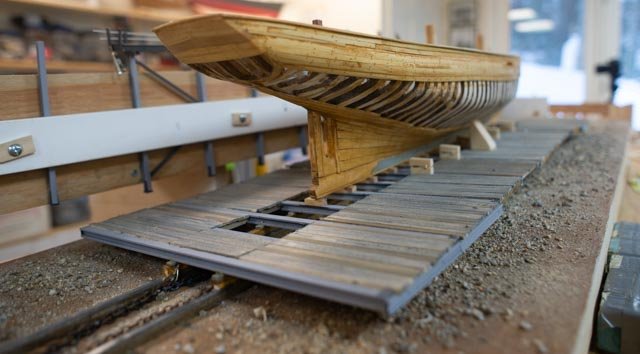 here I have drilled, resanded and restrained the starboard side. This view from aft also shows the transom upper half now planked as well.
here I have drilled, resanded and restrained the starboard side. This view from aft also shows the transom upper half now planked as well.
-
259
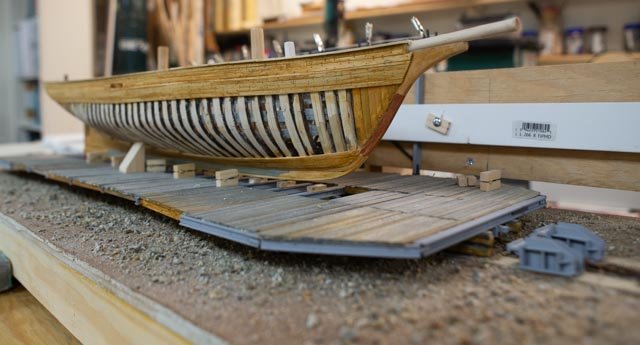 this view from the bow. Note I have fit a bowsprit to help complete the bow.
this view from the bow. Note I have fit a bowsprit to help complete the bow.
-
260a
 here in 2 stacked photos, the whole set up is clearer. One can also see progress on the port side steel structure for the railway.
here in 2 stacked photos, the whole set up is clearer. One can also see progress on the port side steel structure for the railway.
- 260 b
Next up more railway progress
Cheers
- allanyed, Roger Pellett and Richvee
-
 3
3
-
251
-
Post 24
Steel work coming along and a need to plan docks.
Every day that I can work on this project I have been adding more and more inside. I believe in another week or so I can stop. In the meantime, I need to finish the basic hull construction, so that I can finalize the finishing process. The railway could either stay simple or become a real rabbit hole. I am going through the process and will share my thought process.
The hull
-
241
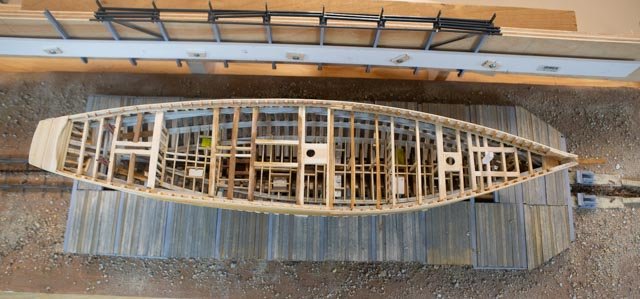 this shot is intended to give a progress view of what the innards will look like. I have a dozen or so more lower deck beams to install and then decide what to do about its decking. After that phase I will complete the main deck beams.
this shot is intended to give a progress view of what the innards will look like. I have a dozen or so more lower deck beams to install and then decide what to do about its decking. After that phase I will complete the main deck beams.
-
242
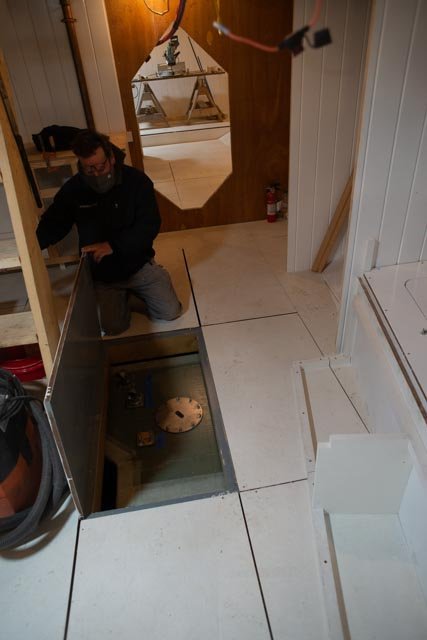 this photo shows the build out of the lower deck. The deck beams are often removable, and all of the panels of marine plywood can come up. Here we see a waste tank. There is still 60,000 pounds of lead ballast to be placed, and access to below decks will be continuous. There will be fir decking over these panels at the very end of the construction. In some earlier photos we saw plywood laid out for working platforms during the construction. What I will try is to place a few sheets to reflect that purpose and temporary construction planking to support a few construction ladders.
this photo shows the build out of the lower deck. The deck beams are often removable, and all of the panels of marine plywood can come up. Here we see a waste tank. There is still 60,000 pounds of lead ballast to be placed, and access to below decks will be continuous. There will be fir decking over these panels at the very end of the construction. In some earlier photos we saw plywood laid out for working platforms during the construction. What I will try is to place a few sheets to reflect that purpose and temporary construction planking to support a few construction ladders.
-
243
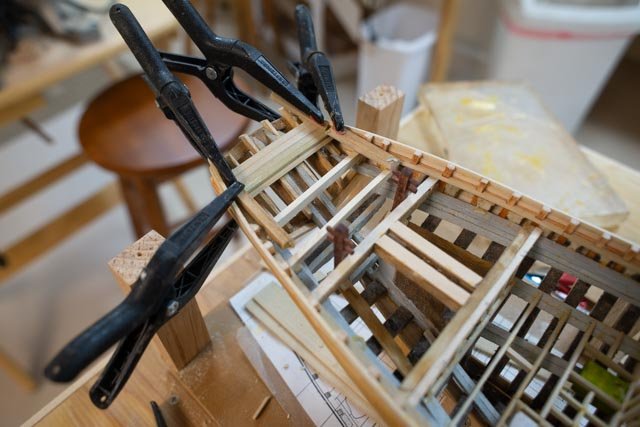 I have laid out the first cap rail and will be fitting it next, as soon as all the waterways are in. I have started with the transom area and that also shows in the following photos. I hope to clean that up for next time.
I have laid out the first cap rail and will be fitting it next, as soon as all the waterways are in. I have started with the transom area and that also shows in the following photos. I hope to clean that up for next time.
The diorama
Lots of progress this week. The first stage was humorous.
-
244
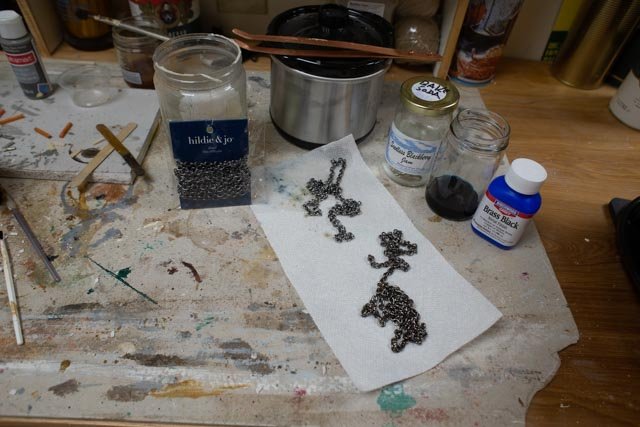 I upgraded my blackening equipment this year to include the little slow cooker for better temperature while pickling. I then went to Michaels and Joann’s and bought several sizes of chain. What I found was a mystery material from china. I tried it even though it was magnetic, and to no surprise it did not work. I did get some form of coating off because after the whole process including the blackening process it was quite bright.
I upgraded my blackening equipment this year to include the little slow cooker for better temperature while pickling. I then went to Michaels and Joann’s and bought several sizes of chain. What I found was a mystery material from china. I tried it even though it was magnetic, and to no surprise it did not work. I did get some form of coating off because after the whole process including the blackening process it was quite bright.
Off to the garage we went for spray paint with auto primer. That worked nicely and then I am using a combination of artist acrylic to simulate the variety of colors. Rust, slime seaweed paint spills etc.
-
245
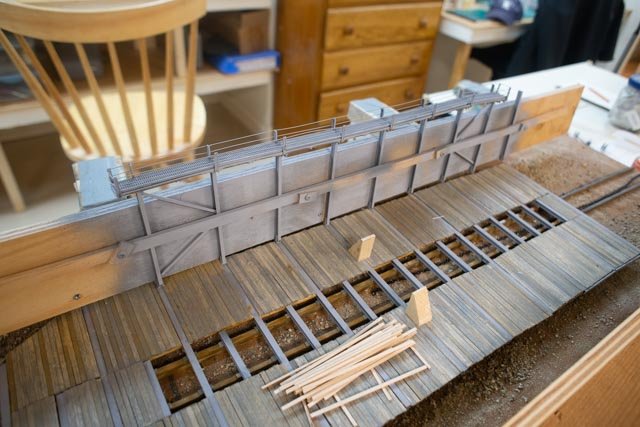 also off to the garage to spray out the ABS steel frame. I am happy with it, but I ran out and the next can is a different shade of gray…….oops
also off to the garage to spray out the ABS steel frame. I am happy with it, but I ran out and the next can is a different shade of gray…….oops
-
246
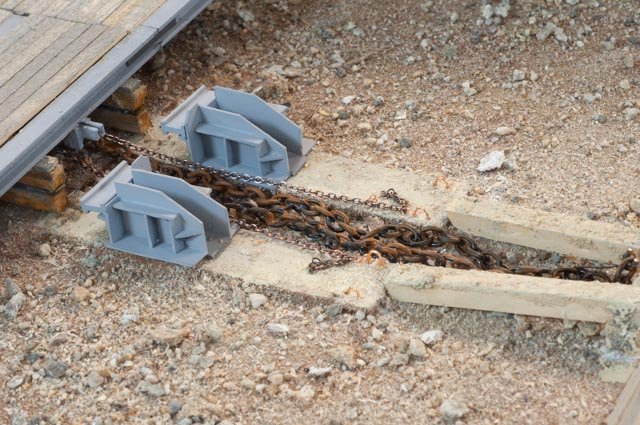 here we see ABS gray steel, painted chain and the beginnings of simulated concrete.
here we see ABS gray steel, painted chain and the beginnings of simulated concrete.
Next up is the blocking.
-
247
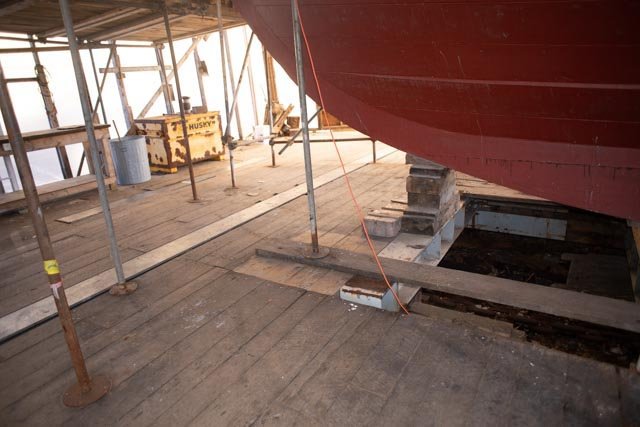 here is the most complicated one. It will surely go in last.
here is the most complicated one. It will surely go in last.
Overview
-
248
 here we are sitting on new blocking with the second side [ north] steel frame being assembled. I added to the photo where I need to decide if I am going to build the dock, I think I will at this point
here we are sitting on new blocking with the second side [ north] steel frame being assembled. I added to the photo where I need to decide if I am going to build the dock, I think I will at this point
-
249
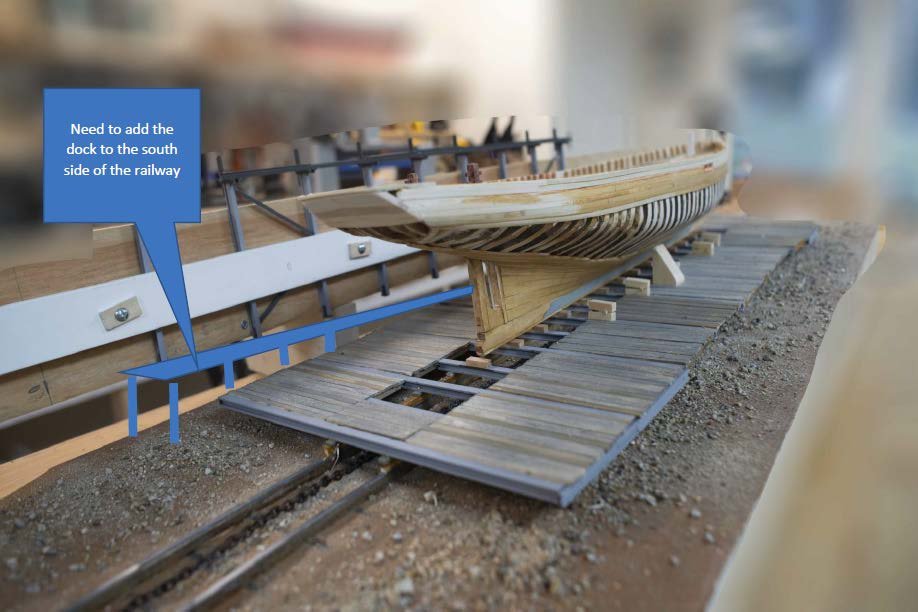 here we are looking from the west end. The transom is coming along. It is clearly the most difficult part. The chain and track and soil at this end will need more painting and seaweed. Again, I show the dock that I plan to try to do.
here we are looking from the west end. The transom is coming along. It is clearly the most difficult part. The chain and track and soil at this end will need more painting and seaweed. Again, I show the dock that I plan to try to do.
-
250
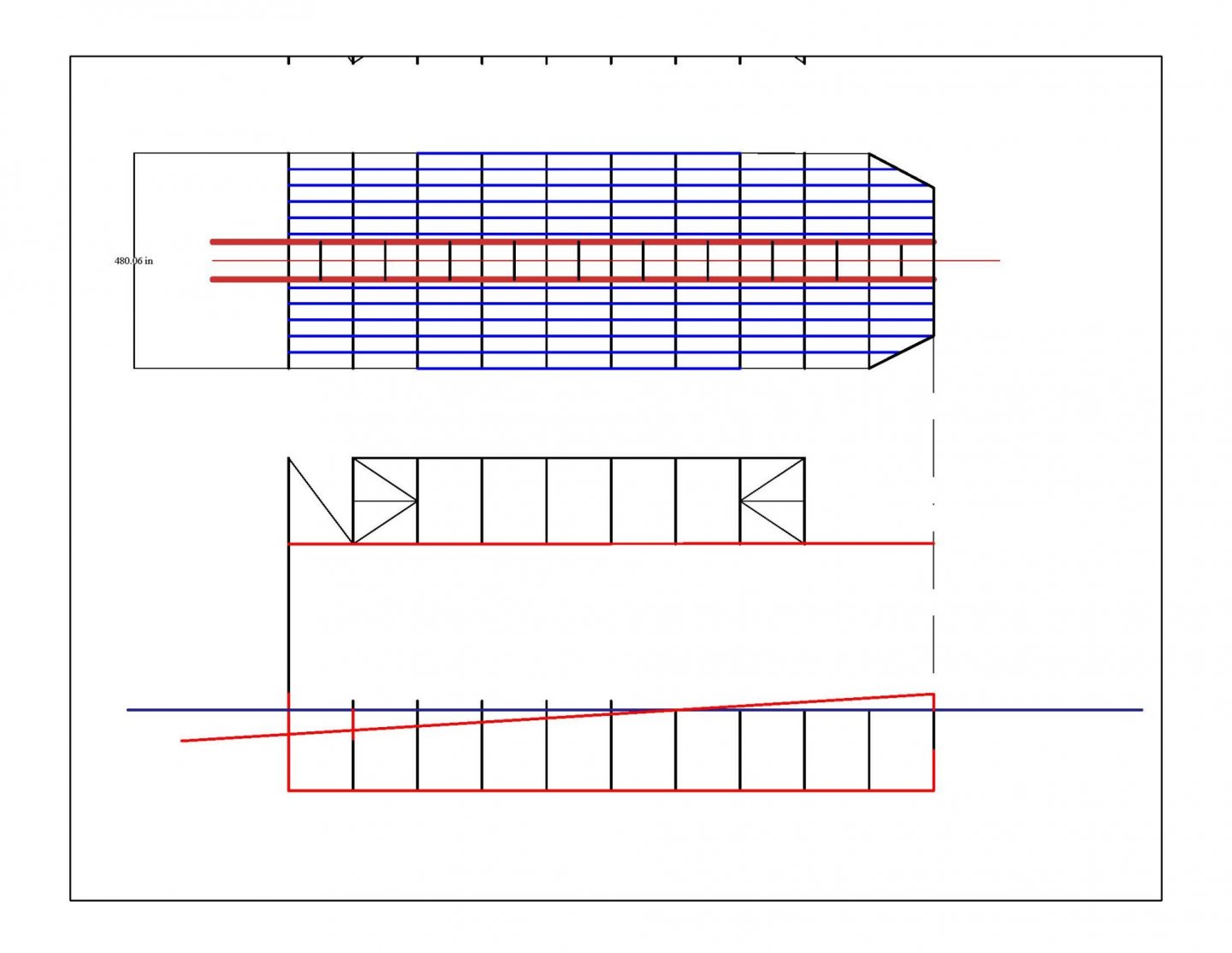 this drawing shows my figuring out how to make the slopes work to fit the dock to the railway properly. I have several photos and believe I can get it right. I must slope the existing diorama about 5/8” one end, so the red slope fits a level dock.
this drawing shows my figuring out how to make the slopes work to fit the dock to the railway properly. I have several photos and believe I can get it right. I must slope the existing diorama about 5/8” one end, so the red slope fits a level dock.
All for now
-
241
-
-
Post 23
Sometimes we get ahead of ourselves.
I was able to get to the yard last week as it was not a workday. I went through many things and learned a lot more. It should not be surprising that not having been there for a while I got ahead of myself on a few details. Oops we say that is why they invented saws and chisels
What I missed of note is that there is a step in the lower deck directly under the main deck step. fortunately it is too slight to really notice so i shall just declare it to be an oops. I also mis labeled an earlier photo of tanks [ I just edited it in the last post] and now I will fix the tanks. I also learned there are three materials, stainless, fiberglass which has a green tint and a white painted different plastic for gray water. I will now go through and make a few changes. I will also declare that I will not have all the tanks in exactly the right place as i do not have drawings, only my memory. There are many of them and even today they are not all there yet.
I saw more about what was completed in the Cape Verde rebuild of the 1980’s. I will make the pieces, as I learn about them, stand out somehow. Typically is means dark stain on wood and already painted on painted parts. A little Progress as I got diverted back to my old Bluenose schooner sails that were never completed. i will post that when done on that log some time in the spring .
-
231
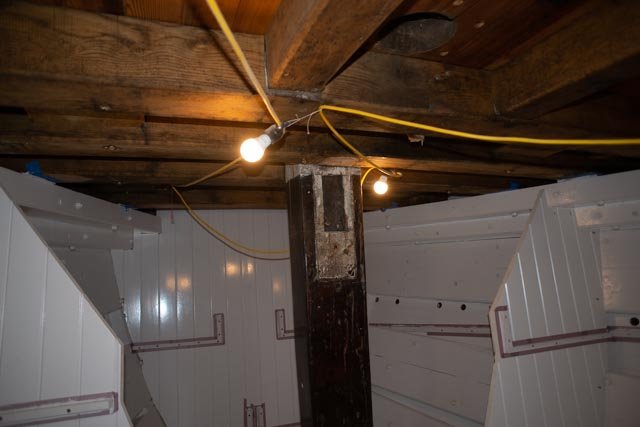 here we see below the old Cape Verde 1980 rebuilt Sampson post
here we see below the old Cape Verde 1980 rebuilt Sampson post
-
232
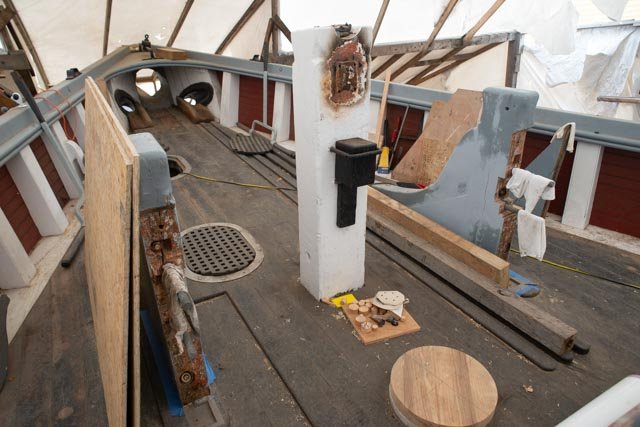 Here on deck we see both the Sampson post and the windlass is to be refurbished and saved
Here on deck we see both the Sampson post and the windlass is to be refurbished and saved
-
233
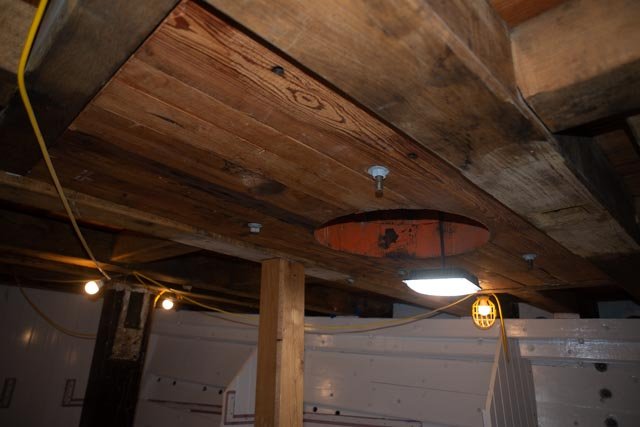 underside view of mast partners show 6 inch thick and Douglas fir
underside view of mast partners show 6 inch thick and Douglas fir
-
234
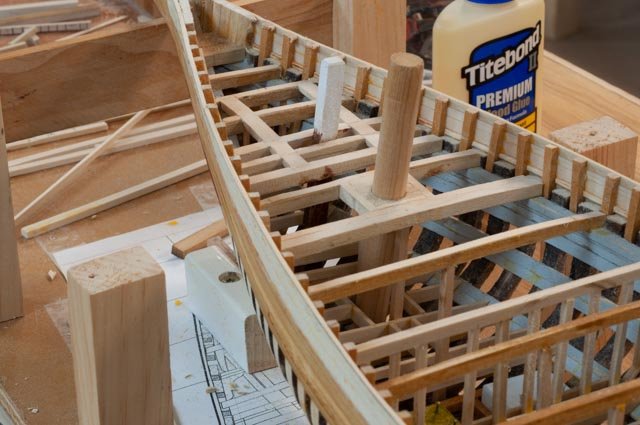 for this stage I have painted the top white and stained the lower section walnut to identify this as being salvaged.
for this stage I have painted the top white and stained the lower section walnut to identify this as being salvaged.
-
235
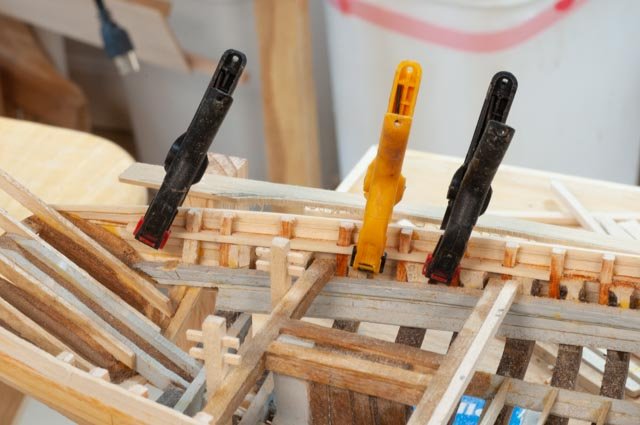 here I am starting the inside half of the waterway
here I am starting the inside half of the waterway
-
236
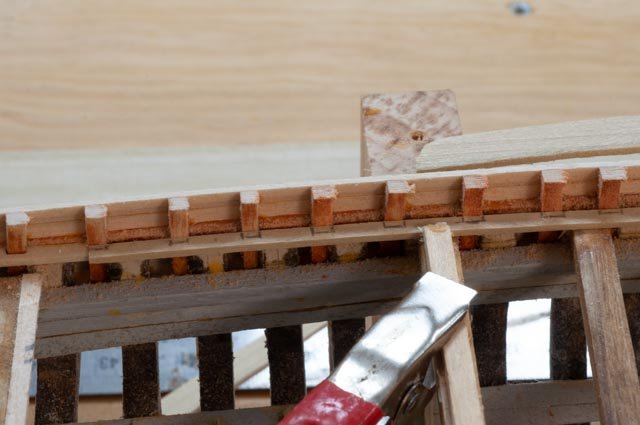 I lay down a section and mark the stanchions and then cut and file the notch off the boat. The combined width reflects 12 inches. It is not enough for all the “sawtooth” projections to receive the planks. More on that subject later
I lay down a section and mark the stanchions and then cut and file the notch off the boat. The combined width reflects 12 inches. It is not enough for all the “sawtooth” projections to receive the planks. More on that subject later
-
237
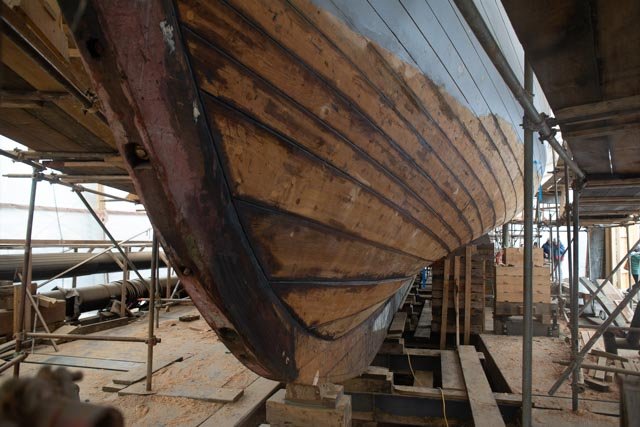 here we see that the lower bow stem piece also survives from the 1980-85 Cape Verde rebuild. It was quite dark at this stage reflecting its age.
here we see that the lower bow stem piece also survives from the 1980-85 Cape Verde rebuild. It was quite dark at this stage reflecting its age.
-
287
 I have stained this section to reflect the old wood.
I have stained this section to reflect the old wood.
-
239
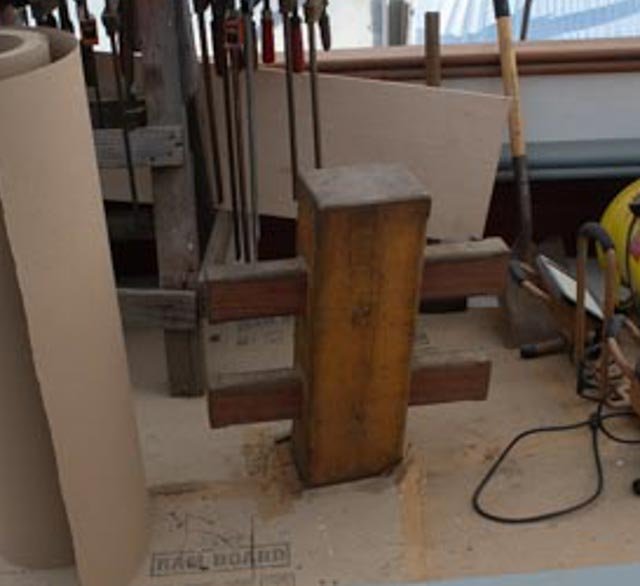 here is the aft bitts that are staying with us also from Cape Verde
here is the aft bitts that are staying with us also from Cape Verde
-
240
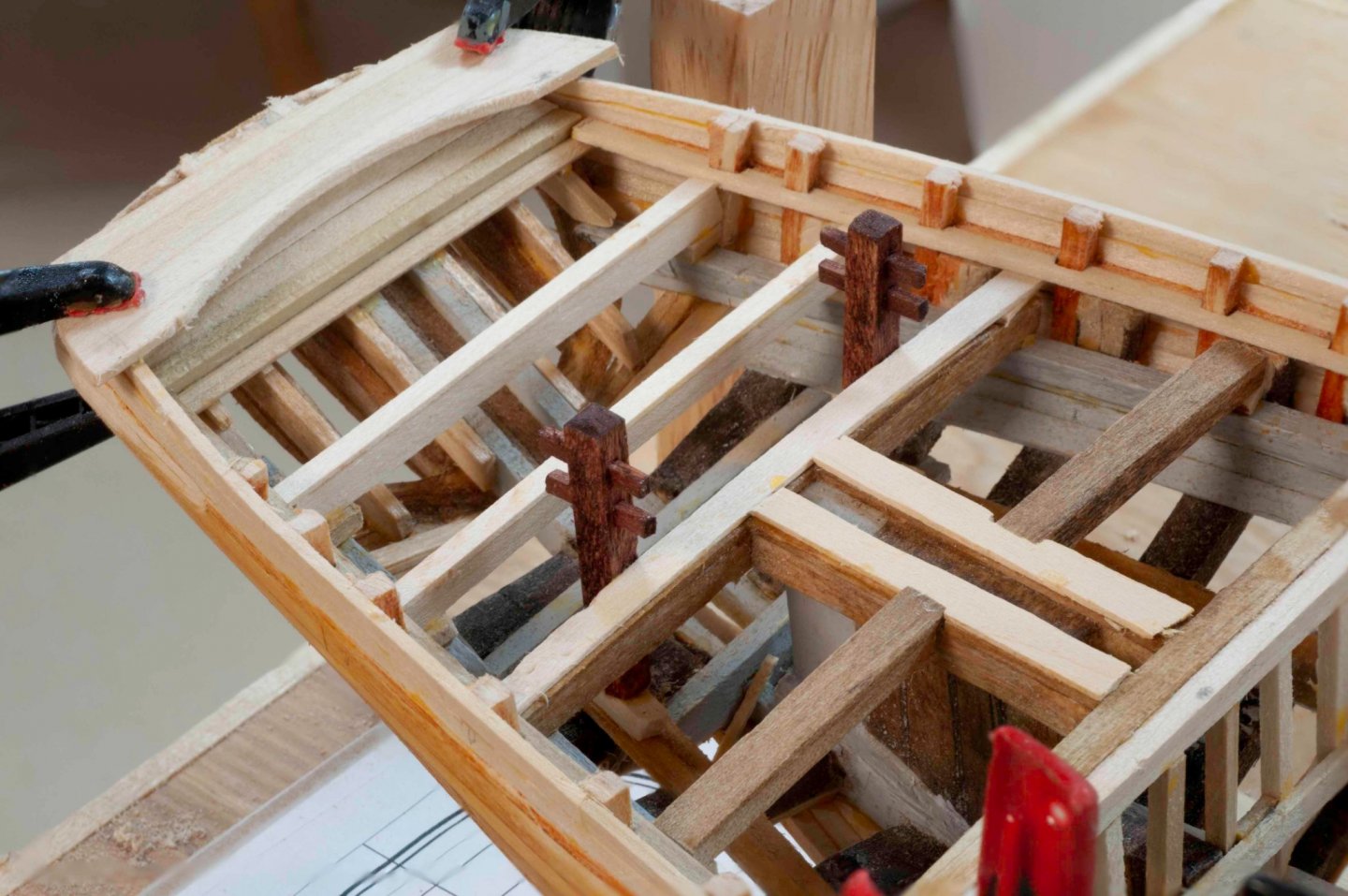 here I have stained the bitts dark to standout as Cape Verde components. they came out too dark so more on that to come. Now that the waterways are in place, I am better able to dress up the deck beams to fair them out. They will all get sanded and restrained soon. In this view I am starting the aft rail. I want to get this main cap rail on, complete the waterways and then think about what decking I might do as I deal with the un trimmed [ nibbed] waterway
here I have stained the bitts dark to standout as Cape Verde components. they came out too dark so more on that to come. Now that the waterways are in place, I am better able to dress up the deck beams to fair them out. They will all get sanded and restrained soon. In this view I am starting the aft rail. I want to get this main cap rail on, complete the waterways and then think about what decking I might do as I deal with the un trimmed [ nibbed] waterway
There is a lot more inside that i have gotten done. it is hard to photo. I need to figure out how far to go. I am thinking to leave out most of the lower decking to allow views of the inside frames, but will need to do something. Maybe next time. Also, the missing ABS just came in. I will get back into the railway too.
All for now
-
231
-
Alan
This log has been a great adventure for many of us amateur schooner buffs as well as the experts who added much. I was at the yard today and saw your model in the flesh. it is a joy to see.
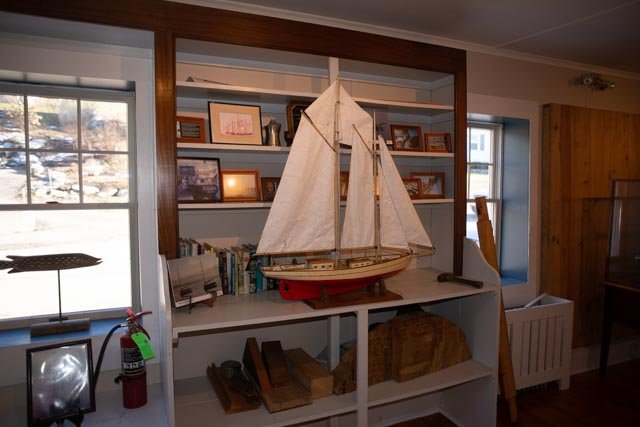 Here she lays for now anyway
Here she lays for now anyway
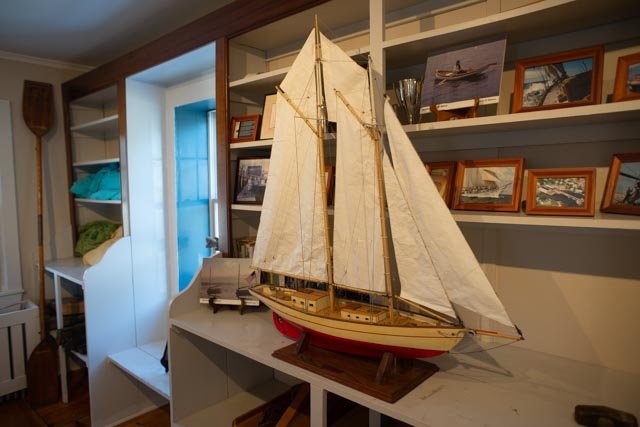
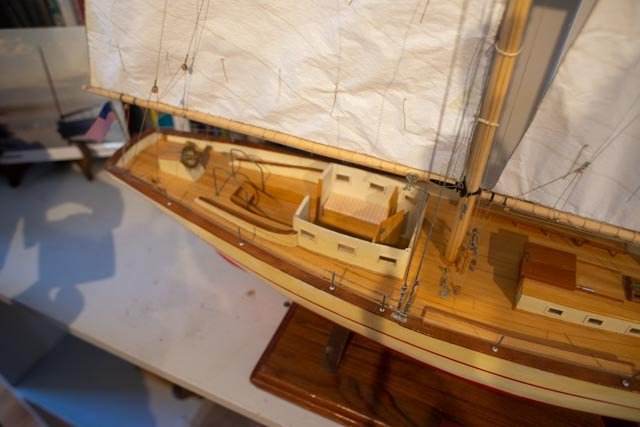 Eric, the yard director, was happy to come over and take off the cabin roof for me to see inside.
Eric, the yard director, was happy to come over and take off the cabin roof for me to see inside.
great work and lots learned by reading you log
cheers
jon
-
Alan
I was able to go today as the work was off for Friday. it was 22 degrees and a little icey but I got some great information. I will be including some of it in the next post as I found a few things i was doing wrong and few more differences in this new design. I also saw you model and will post the photo in your log
cheers
-
Post 22
Continued work below deck
The next few posts will include elements where I take some information from the real schooner and attempt to represent that image in the model. As I am always learning, some try’s will work out and some will leave opportunity for future learning....
First, where are we at the beginning of 2021? We have about four months left till show time, so pressure will begin to build.
Beginning of 2021. We are still in the covid bubble.
-
219
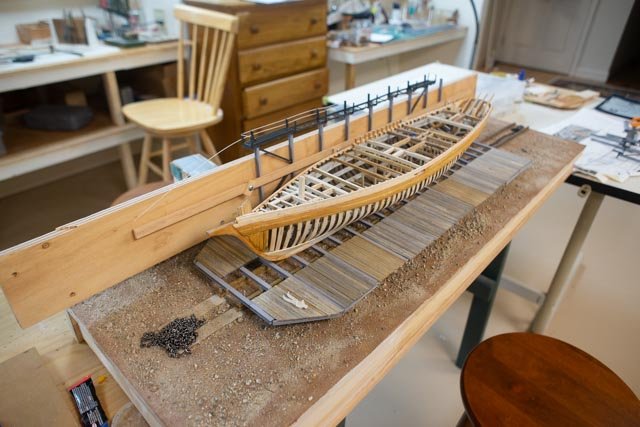 here we see bulwarks recently added on the port side and stanchions going in to starboard. The white styrene handrails on the steel structure are on hold waiting for more ABS material that needs to go in first.
here we see bulwarks recently added on the port side and stanchions going in to starboard. The white styrene handrails on the steel structure are on hold waiting for more ABS material that needs to go in first.
-
220
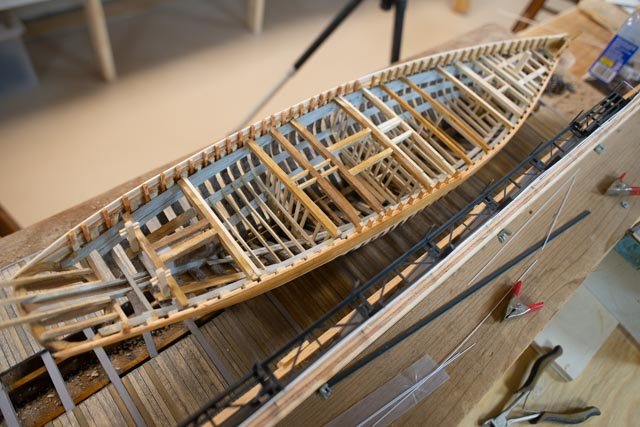 looking down we see the new lower deck framing started. Laugh at me as it is all 3x 9 inch joists. [ oops for later]
looking down we see the new lower deck framing started. Laugh at me as it is all 3x 9 inch joists. [ oops for later]
-
221
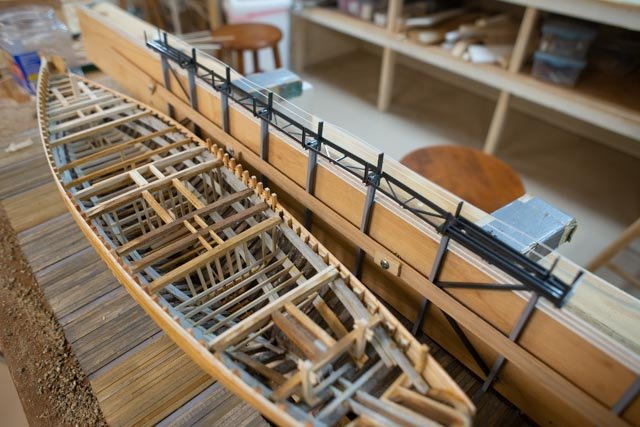 looking forward we see some main deck added elements like the windless supports, mast partners and a few more beams
looking forward we see some main deck added elements like the windless supports, mast partners and a few more beams
-
222
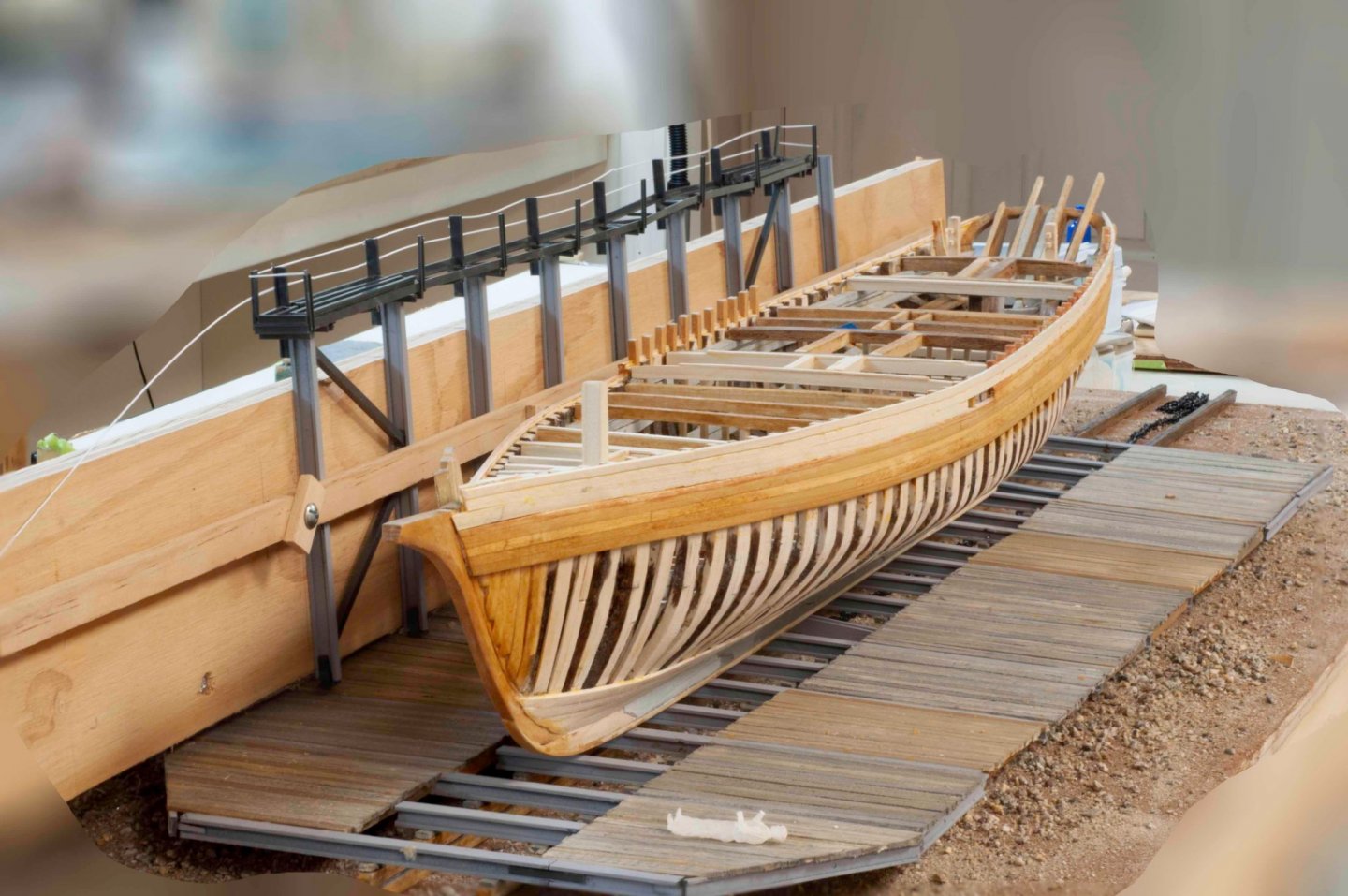 Here is our year beginning stacked, blurred, cropped etc. photo. Unfortunately I was not aware our crew member was napping on the job.
Here is our year beginning stacked, blurred, cropped etc. photo. Unfortunately I was not aware our crew member was napping on the job.
Below deck study. I have collected here a group of photos from which I am basing the work below deck. Little of this detail would be here before all planking and decking were in place.
-
223
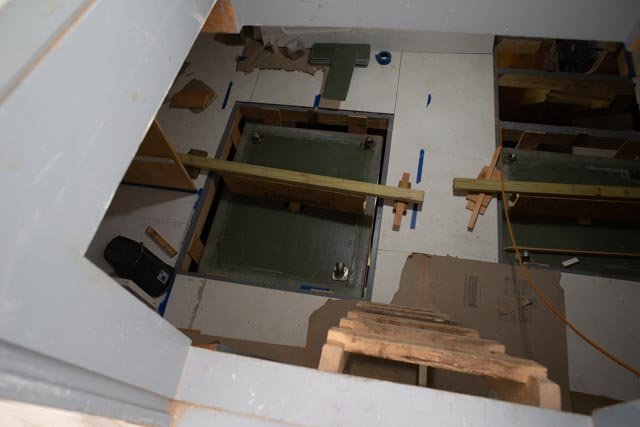 here is an image into the captains cabin showing two tanks below the lower deck. I also like the construction ladder. This area is a bunk room for added adventurers
here is an image into the captains cabin showing two tanks below the lower deck. I also like the construction ladder. This area is a bunk room for added adventurers
-
224
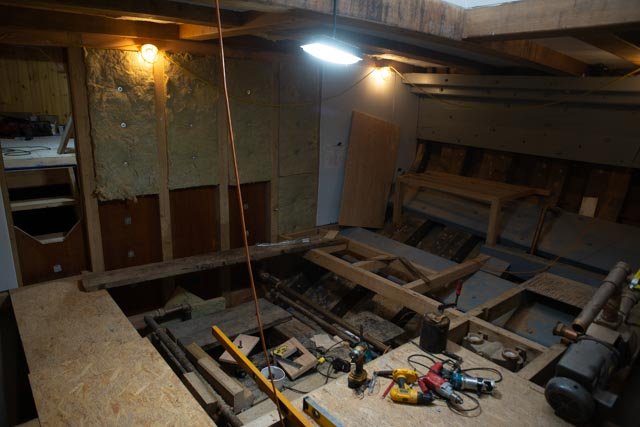 here we see the engine room under way before arrival of the engine
here we see the engine room under way before arrival of the engine
-
225
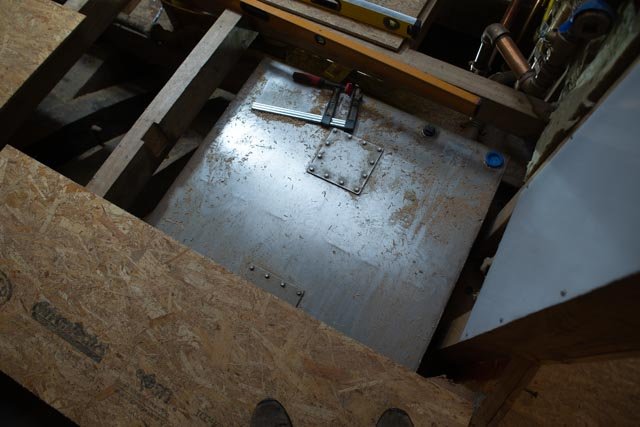 here is an underdeck tank in the engine room.
here is an underdeck tank in the engine room.
226a
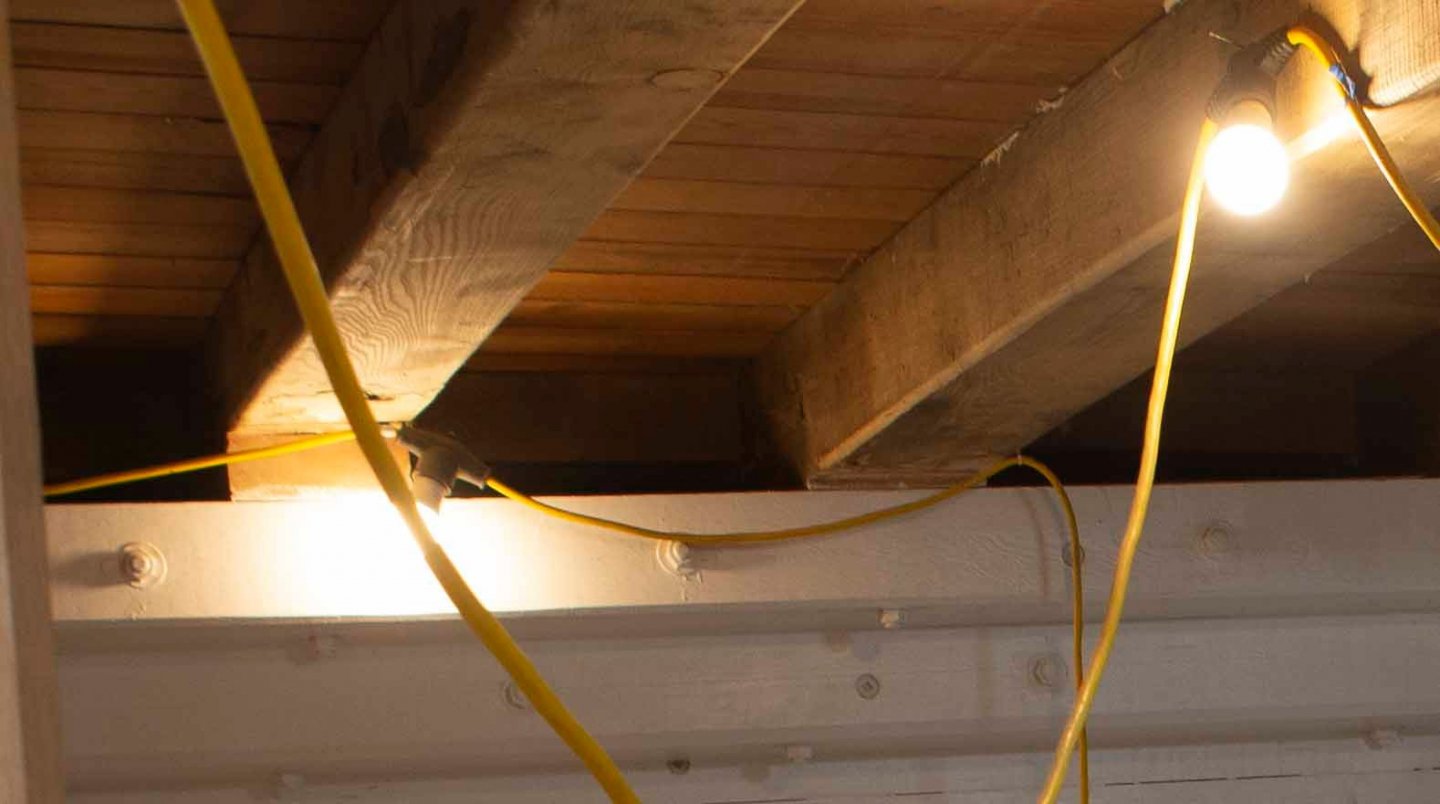 here is a detail that is a ‘bridge too far for’ me at least. Note that some of the deck beams are perhaps 2 or 3 inches thinner than the others and have shims. The nominal beams from the 2006 drawings are 9 inches and all of mine represent that dimension. Also tucked behind on top of the shelf is a 6-inch-deep fore and aft beam that must beef up the edge of the water way where planks end in between beams. This area is open and allows circulation of air to keep out the moisture from condensation that would cause rot.
here is a detail that is a ‘bridge too far for’ me at least. Note that some of the deck beams are perhaps 2 or 3 inches thinner than the others and have shims. The nominal beams from the 2006 drawings are 9 inches and all of mine represent that dimension. Also tucked behind on top of the shelf is a 6-inch-deep fore and aft beam that must beef up the edge of the water way where planks end in between beams. This area is open and allows circulation of air to keep out the moisture from condensation that would cause rot.
-
226b
 here on deck we see where the fasteners go though along the edge of the waterway. I went below to figure out what they attached to and figured out the beam. Fortunately, the model does not need them.
here on deck we see where the fasteners go though along the edge of the waterway. I went below to figure out what they attached to and figured out the beam. Fortunately, the model does not need them.
-
227
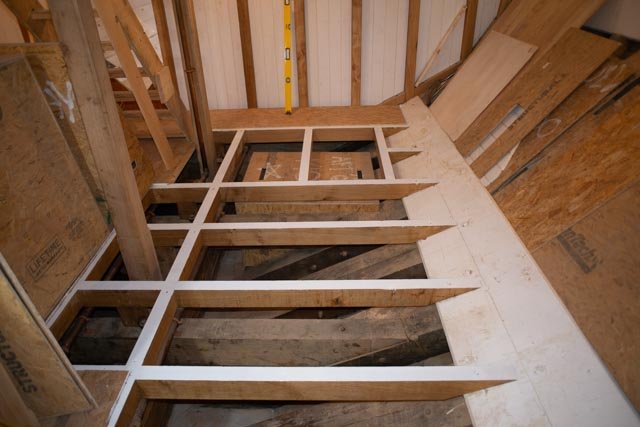 here we are in the galley looking forward, and can see my oops. I need to change the framing. It is clearly 3 by 6 [ I first installed 3 by 9 ] That correction will help where I am squeezing in a tank underneath. I also need to prepare any readers that the clean sharpness in the forms of the framing due to the workmanship of the real thing are not carried through in my work....sorry
here we are in the galley looking forward, and can see my oops. I need to change the framing. It is clearly 3 by 6 [ I first installed 3 by 9 ] That correction will help where I am squeezing in a tank underneath. I also need to prepare any readers that the clean sharpness in the forms of the framing due to the workmanship of the real thing are not carried through in my work....sorry
-
227b
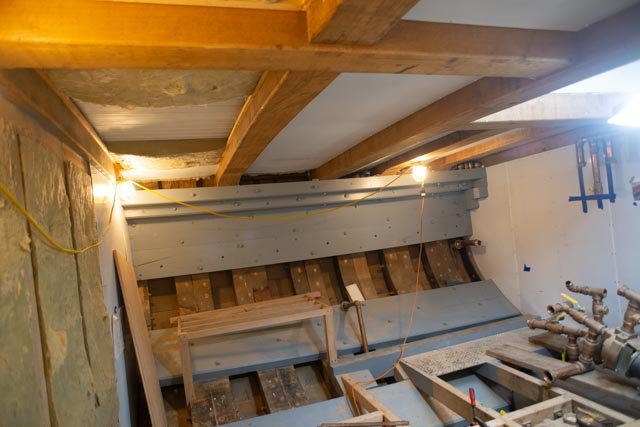 I added this photo where we can see the design. The area between the stringers will be filled in with perforated bead board. The air flow then is continuous to keep things dry. The bulkheads are all insulated and sealed off. to the left side of this photo is the captains cabin, and to the right side is the hold.
I added this photo where we can see the design. The area between the stringers will be filled in with perforated bead board. The air flow then is continuous to keep things dry. The bulkheads are all insulated and sealed off. to the left side of this photo is the captains cabin, and to the right side is the hold.
-
227c
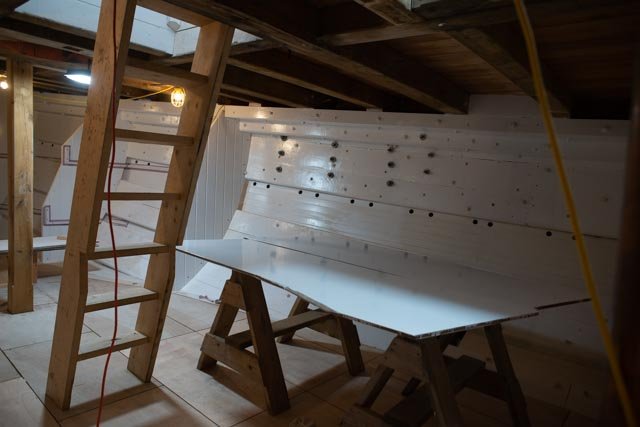 I add this photo as it shows the completed assembly. This is in the foc’sle. Note the holes in the bead board filler panels
I add this photo as it shows the completed assembly. This is in the foc’sle. Note the holes in the bead board filler panels
Model progress
I see in my attempt to document this work I need to find a way to photograph inside. Then I could show each section and make it part of the story board. On the other hand, my workmanship is better viewed from away.
-
228
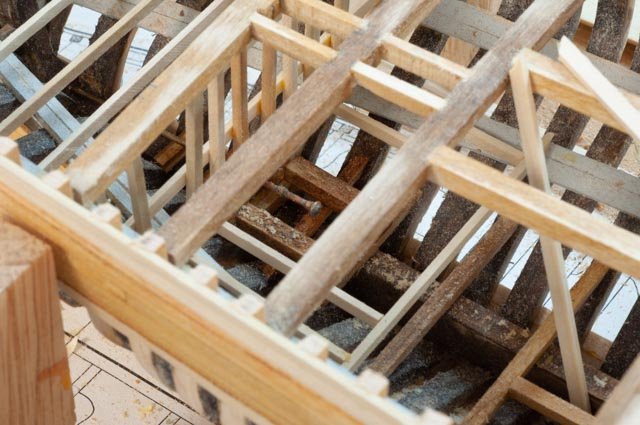 Looking though the deck frame we can see I added a shaft and engine mounts. The framing will make the engine location clear.
Looking though the deck frame we can see I added a shaft and engine mounts. The framing will make the engine location clear.
-
229
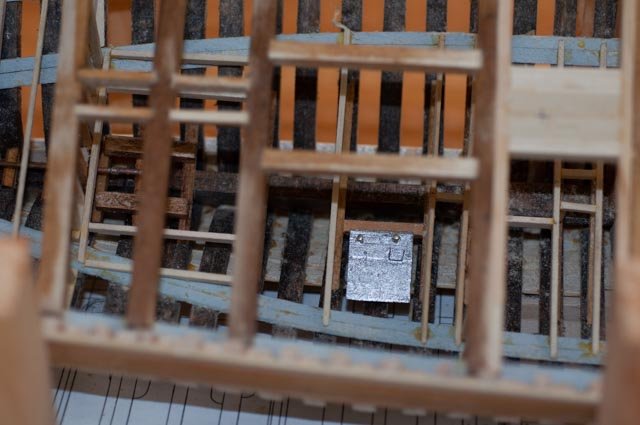 here is the little tank.
here is the little tank.
-
230
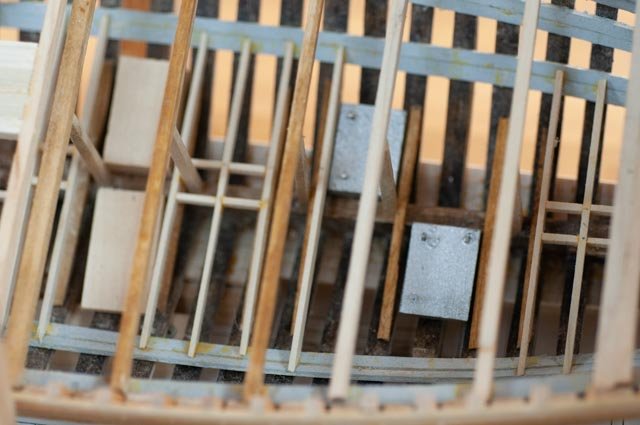 Here is the start on other tanks in the hold area. I will not get all the right tanks in the right places but will try to represent the design in this build to have them there. Example, I doubt there was complete holding tanks that new work will require. the old design had water tanks above the lower deck.
Here is the start on other tanks in the hold area. I will not get all the right tanks in the right places but will try to represent the design in this build to have them there. Example, I doubt there was complete holding tanks that new work will require. the old design had water tanks above the lower deck.
Looking forward
Model
I need to get more of the insides completed so I can decide if I plan to add any more planking. I then need to consider how to finish the planking. Ditto for any decking. I am thinking that below deck I may have some started but the look through is I believe important.
Diorama
I look for missing ABS structural shapes that will let me get past the building of the frame on the car and then set the model on the car to begin adding the movable stands. I have chain now and need to get it blackened and set. There is also a dock to build on the port side. I have worked out the angles etc. and will get into that soon.
All for now
-
219
-
-
post 21
I solved my plan for ABS structure and started interior work on the hull.
Christmas week always knocks us off schedule. This year was no different. After the last posting, I decided to build the car in place and make it secure. I will then somehow get the ABS structure built and set-in place once.{ I hope] So, for the holiday pictures we made a little progress
-
209
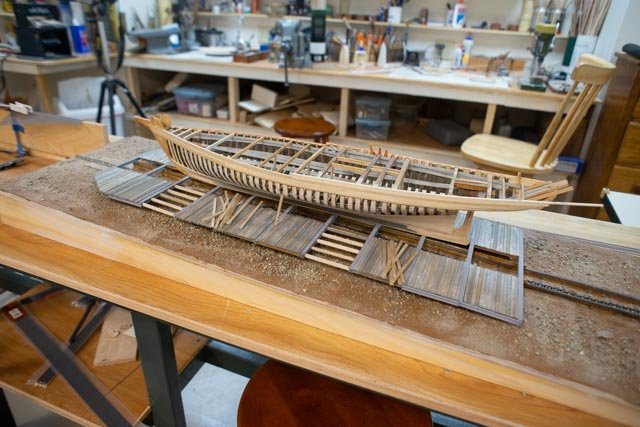 here we see the combined project. The car is now pinned in place and the final sections are being planked.
here we see the combined project. The car is now pinned in place and the final sections are being planked.
-
211
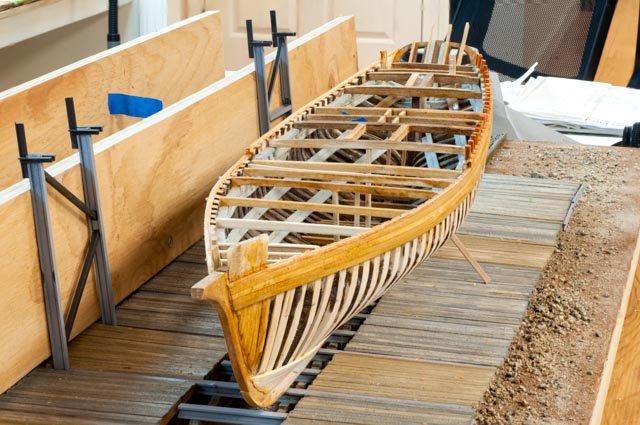 here is one of my presents to myself. I took the time over Christmas to master the art of stacking photos so I can get the whole schooner in focus
here is one of my presents to myself. I took the time over Christmas to master the art of stacking photos so I can get the whole schooner in focus
Now to work on the ABS steel structure. I have now made three orders to Plastruct and I probably will need a fourth. I started over sizing members and now think I have the right combination. I also figured out how to connect pieces. It is just like soldering…..so
-
212
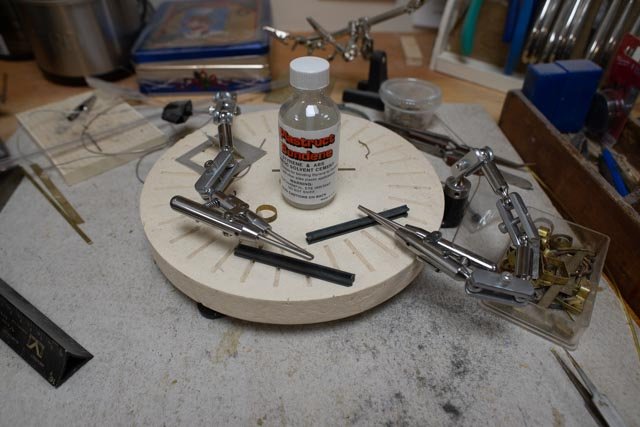 here I have taken over the soldering bay to preassemble the little pieces of plastic.
here I have taken over the soldering bay to preassemble the little pieces of plastic.
-
213
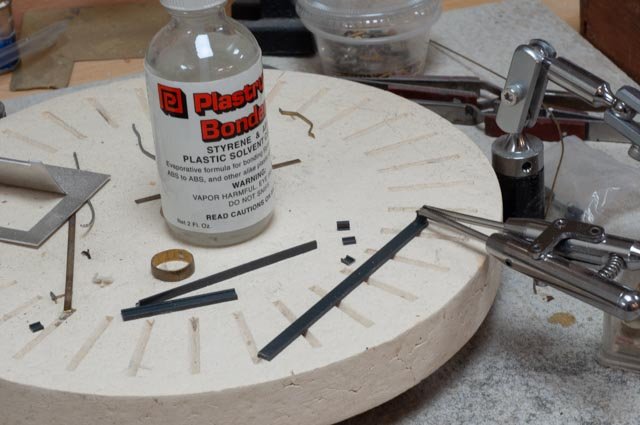 they have to be held together and then solvent glue applied to “weld” them together.
they have to be held together and then solvent glue applied to “weld” them together.
-
214
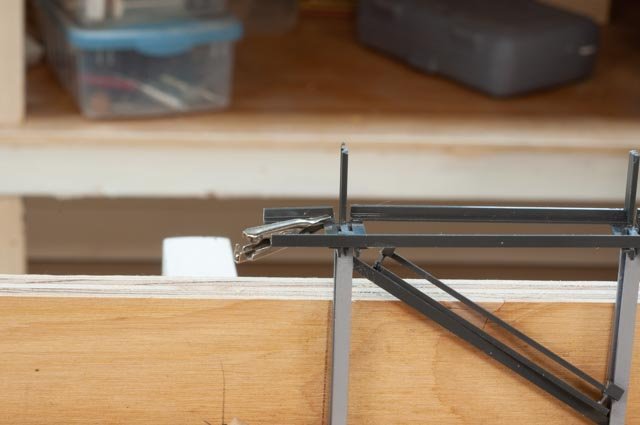 up in the air can be an experiment in clamps.
up in the air can be an experiment in clamps.
-
215
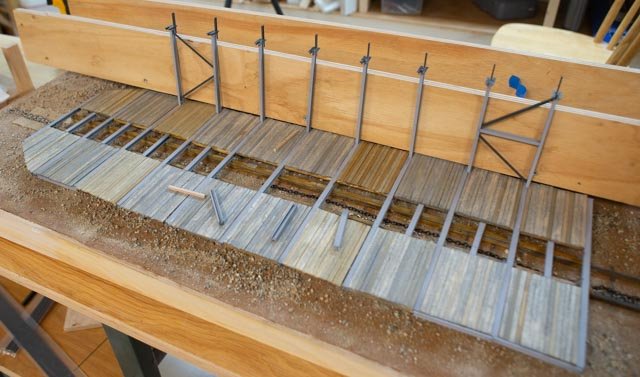 here I have rearranged the jig. It is laid back at 5 degrees for the cant.
here I have rearranged the jig. It is laid back at 5 degrees for the cant.
-
216
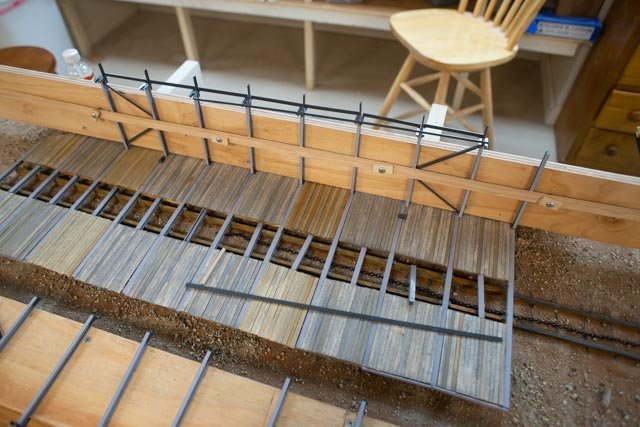 here is my solution to the problem. The ¾ strip is held by through bolts to be snug to hold things in place. I plan to build out the side assemble and then take it to the garage for spray paint. More later
here is my solution to the problem. The ¾ strip is held by through bolts to be snug to hold things in place. I plan to build out the side assemble and then take it to the garage for spray paint. More later
The hull
-
217
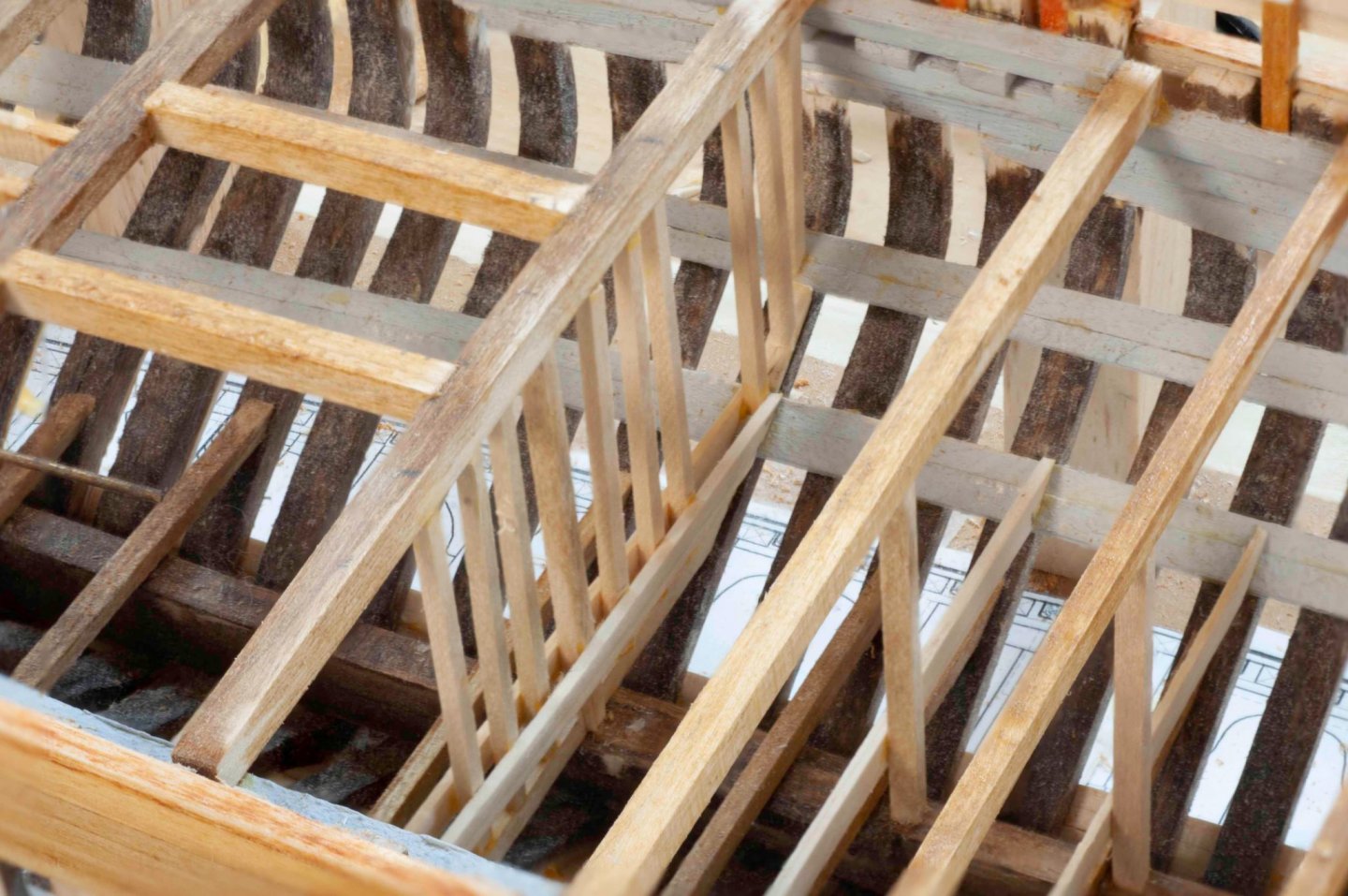 Here in a stacked photo, we actually can see some progress on the interior hull work. This shot shows what I meant earlier when I clarified I will try to do enough of the framing to better explain the make up of the schooner and not stick to a more authentic sequence or better said snapshot. At a time, when a lot of planking is still not installed, the bulked framing in this photo would not have been in place.
Here in a stacked photo, we actually can see some progress on the interior hull work. This shot shows what I meant earlier when I clarified I will try to do enough of the framing to better explain the make up of the schooner and not stick to a more authentic sequence or better said snapshot. At a time, when a lot of planking is still not installed, the bulked framing in this photo would not have been in place.
-
218
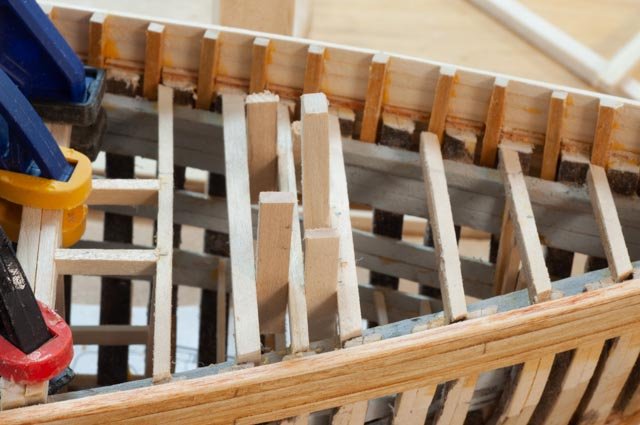 in this photo, the Sampson post is in and I am aligning the deck beams that will get inserted supports for the windless. I am working both the lower deck and the top deck at the same time. I found if I run through the lower deck, when I drop in a post, it does not always hit the lower beams just right, and I may need to remove and adjust. Anyway, I am making this part up as I go. On the far side of the photo the bulwarks are in place on the port side.
in this photo, the Sampson post is in and I am aligning the deck beams that will get inserted supports for the windless. I am working both the lower deck and the top deck at the same time. I found if I run through the lower deck, when I drop in a post, it does not always hit the lower beams just right, and I may need to remove and adjust. Anyway, I am making this part up as I go. On the far side of the photo the bulwarks are in place on the port side.
All for today
-
209
-
Allan
I thought you might like a photo of the recently abandoned Ernestina anchor. According to Ross, they had one of each when they showed up a few years back. A wood "banks" stock [ in photo below] and loose metal "club" stock. They will apparently be building new anchors and he is not yet sure what design. I am sure like Bluenose II it will be more about the coast guard than history.
enjoy your holiday
jon
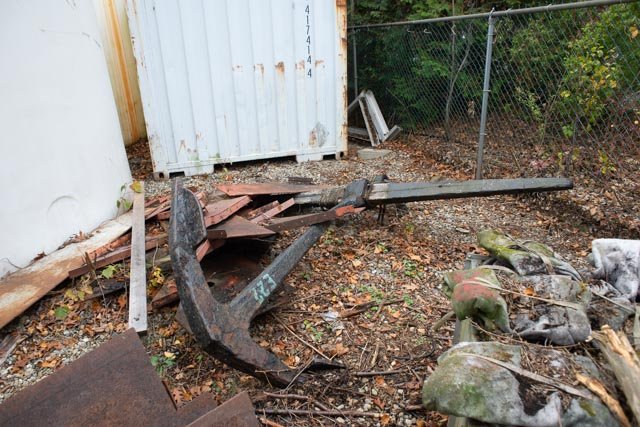
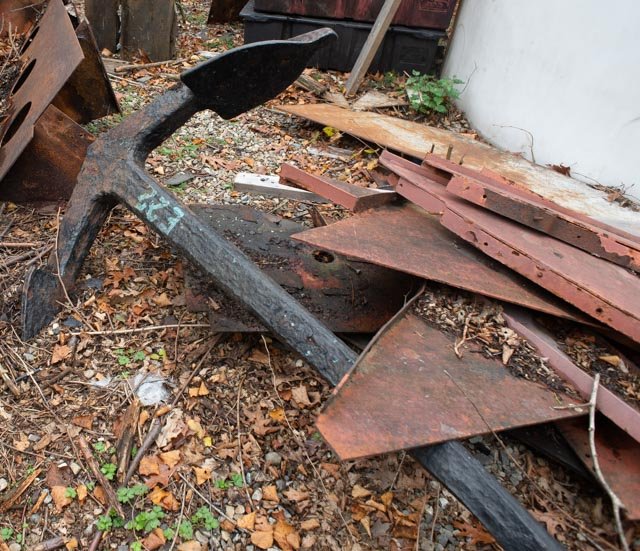
-
Post 20
Waterway and stanchions and railway car platform planning
I find as I sit here to gather my thoughts and maintain some workflow that I am suddenly working on many different things at once. Some of what I am doing is jumping ahead to be sure that I do not get two blocked by sequence. Example, I had left out one top whaler on the starboard side thinking I wanted a better view through the frames. I now realize that was silly, so I luckily was still able to get it in and use the little clamps to hold it during glue up. I am also not sure if I want to add more planking. One side is more done than the other, I may revisit that one too but I need to decide before adding the inside lower deck and remaining deck beams. To this week’s progress.
Hull work
I feel it is important to complete the waterways and establish all those lines next. Seeing that in this design the stanchions are not part of the extended frames but added members, I thought about different approaches. In pictures of the real waterways, one may be amazed at the workmanship. The waterways were mortise cut and then set down over the stanchions. Wow, I am not that good. My solution is to install the waterway in parts. First the outer section is a 1/8 plank that I can bend to the curve easily. I then use a small square file for each stanchion. First let’s look at the real thing
-
199
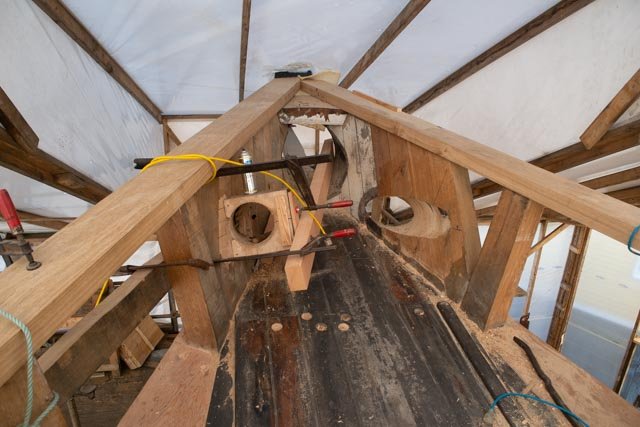 the bow. Wow how to get this look or even close. All the wood here is Douglas fir except the tops of the knightheads. They are the Danish Oak. The fir deck is oiled.
the bow. Wow how to get this look or even close. All the wood here is Douglas fir except the tops of the knightheads. They are the Danish Oak. The fir deck is oiled.
-
200
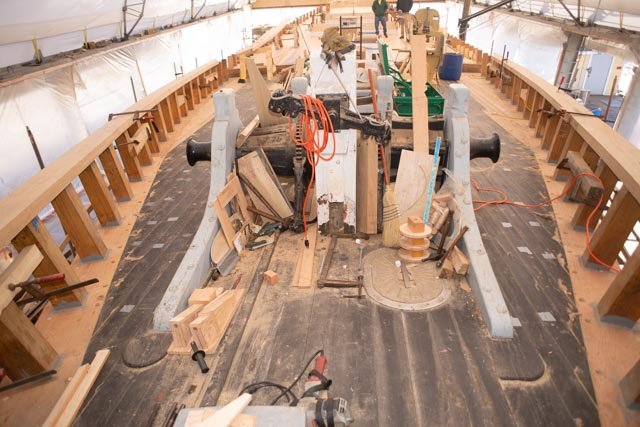 The waterway is 15 inches in the thin areas. I notice a slight reddish to the fir in this light. [ I will try to replicate a slight difference]. Can you imaging the care to mortice the square holes for the stanchions! Here also we see the cap rails. They have mortises with roughly 4”x4” tenons and the are bent to fit as they are three inches thick. Again I say wow
The waterway is 15 inches in the thin areas. I notice a slight reddish to the fir in this light. [ I will try to replicate a slight difference]. Can you imaging the care to mortice the square holes for the stanchions! Here also we see the cap rails. They have mortises with roughly 4”x4” tenons and the are bent to fit as they are three inches thick. Again I say wow
-
201
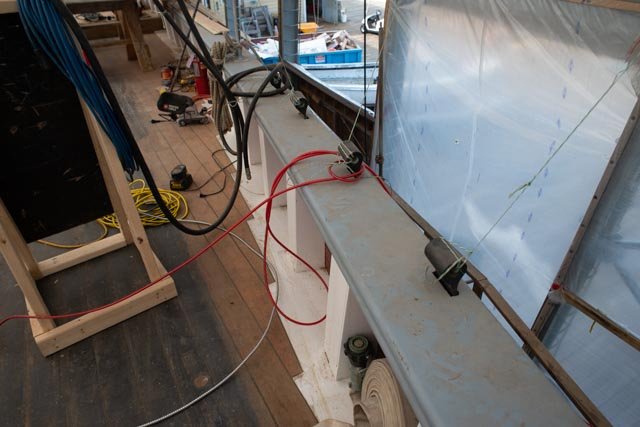 this view is to indicate the widening of the waterway for the ends of each plank. That means wider than 15 inches. That means I need to either bend a piece greater than 3/16” or make the inside in two more pieces. We’ll see what happens.
this view is to indicate the widening of the waterway for the ends of each plank. That means wider than 15 inches. That means I need to either bend a piece greater than 3/16” or make the inside in two more pieces. We’ll see what happens.
-
202
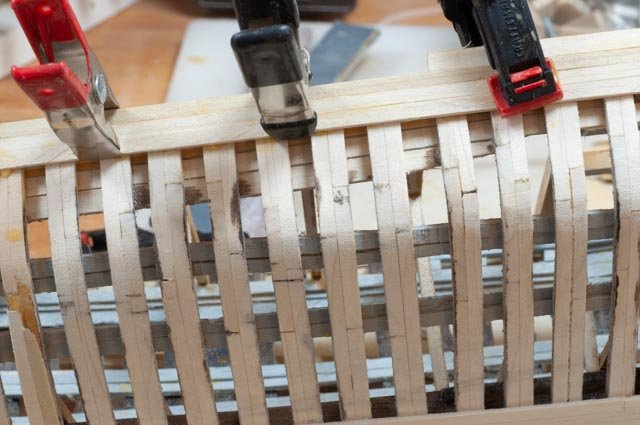 here I am gluing on the outer peace of the waterway
here I am gluing on the outer peace of the waterway
-
203
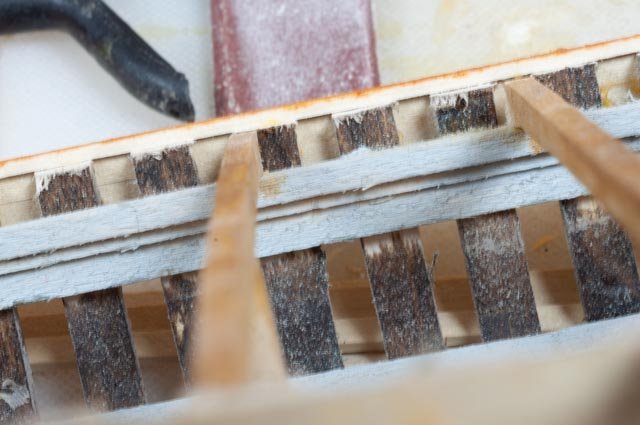 here we see looking across to the starboard side the outer piece of the waterway. Looking down one sees only one of two gray clamps installed. I had thought earlier to leave this off for better views but have decided to install it.
here we see looking across to the starboard side the outer piece of the waterway. Looking down one sees only one of two gray clamps installed. I had thought earlier to leave this off for better views but have decided to install it.
-
204
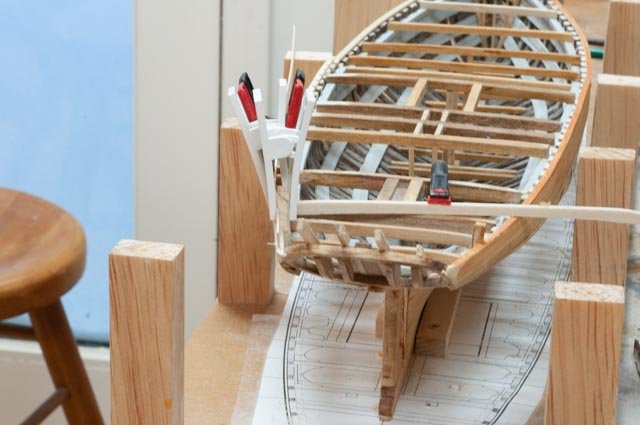 here I am gluing in the first stanchions
here I am gluing in the first stanchions
-
205
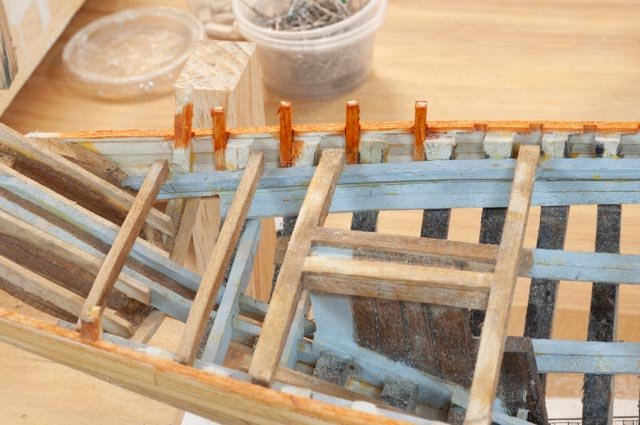 in this view the waterway and the stanchions are in and stained with gunstock to show the redder color than the golden hue of the oiled oak. I think it is too much difference and will not try to tone it down.
in this view the waterway and the stanchions are in and stained with gunstock to show the redder color than the golden hue of the oiled oak. I think it is too much difference and will not try to tone it down.
-
206
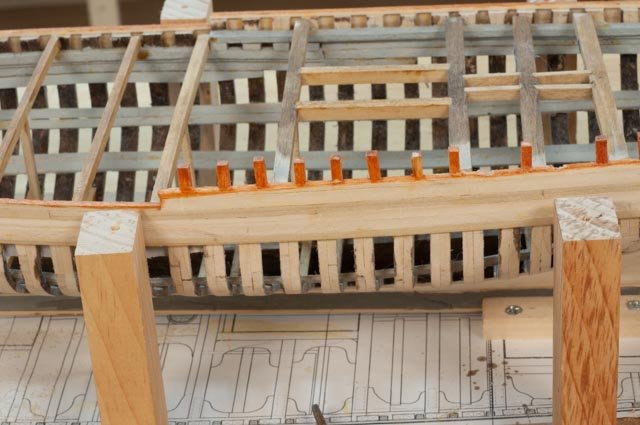 here is the outside view. The missing clamp on the far side is also seen here as I installed it this week as well
here is the outside view. The missing clamp on the far side is also seen here as I installed it this week as well
Diorama
More planning than physical progress. I need to figure out how to build the railway platforms that are canted out as about 5 degrees. I also have several items to preassemble.
-
207
 here I have ripped some 5/4 stock at 5 degrees and then screwed on a scrap piece of plywood to form a potential backboard
here I have ripped some 5/4 stock at 5 degrees and then screwed on a scrap piece of plywood to form a potential backboard
-
208
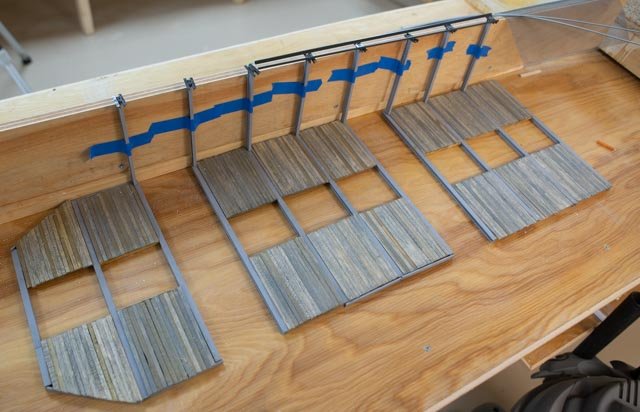 here I am starting to assemble the columns. I have placed them where they will go to start thinking about how to make the platform. The results were to write up another order for more ABS model steel angles to better make the upper platform.
here I am starting to assemble the columns. I have placed them where they will go to start thinking about how to make the platform. The results were to write up another order for more ABS model steel angles to better make the upper platform.
Up next is a need to figure out a plan to use the ABS members to construct the railway car platforms, so that if the process does not work out, I will still have time to think of alternative means and methods. Also do I build the car off the diorama and then take it in for placement, or do i build everything in place? stay tuned.
jon
Cheers
-
199
-
Ernestina and old schooner lovers...
I went back through some photos on the deck. This post will not totally resolve the questions, but it does shed some light.
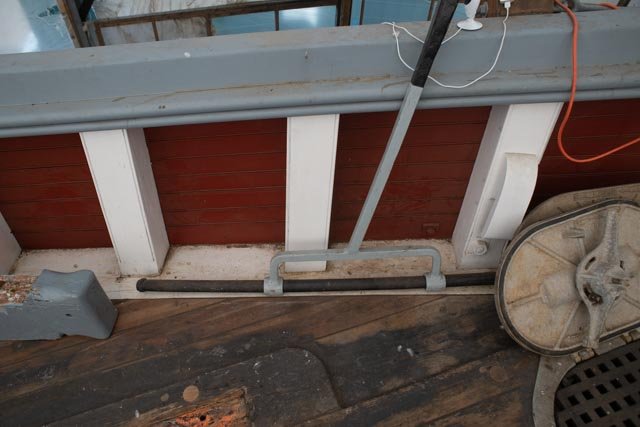 in this photo one orients himself as to the decking coming onto the waterway
in this photo one orients himself as to the decking coming onto the waterway
 In this blow up one can see pegs over fasteners . Also note the linseed oil compound that blackens the whole deck.
In this blow up one can see pegs over fasteners . Also note the linseed oil compound that blackens the whole deck.
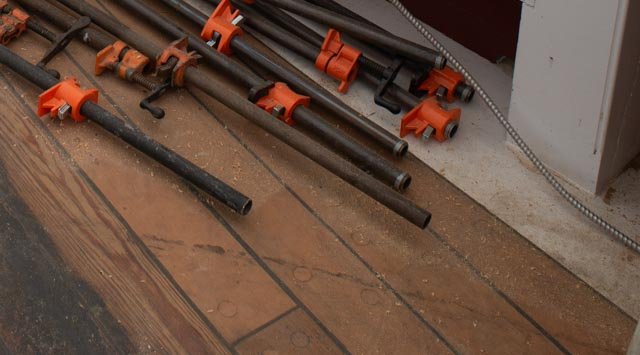 In this photo we see similar plugs following a pattern that is obviously a deck beam. the Douglas fir decking and plugs make it difficult to see in an unfinished condition and totally unlikely to see in an oiled condition. From my reading it is likely that the plugs are cut from the same material that make them act the same, as to expansion, and seem to disappear. Wood trunnels on the other hand would be hackmatack or other harder material than the planking and thus stand out in hull planking.
In this photo we see similar plugs following a pattern that is obviously a deck beam. the Douglas fir decking and plugs make it difficult to see in an unfinished condition and totally unlikely to see in an oiled condition. From my reading it is likely that the plugs are cut from the same material that make them act the same, as to expansion, and seem to disappear. Wood trunnels on the other hand would be hackmatack or other harder material than the planking and thus stand out in hull planking.
This may not be a complete answer and I will look forward to reading here the yard's answer.
cheers
jon
-
Please see photo from a few years ago of Ernestina planking. Trunnels are used throughout . as a plank crosses a frame, see the diagonal pattern. One up in one half of frame and the other down in the other half. Frames are pairs of 6 ", and spaced roughly 2 feet on center. The pattern alternates working up the frame as seen in photo.
Jon.
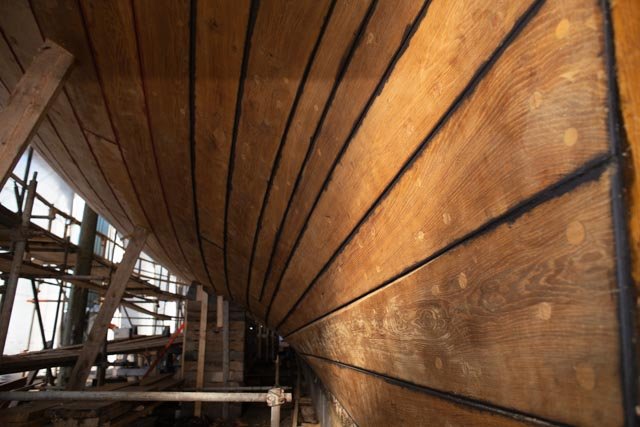


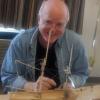
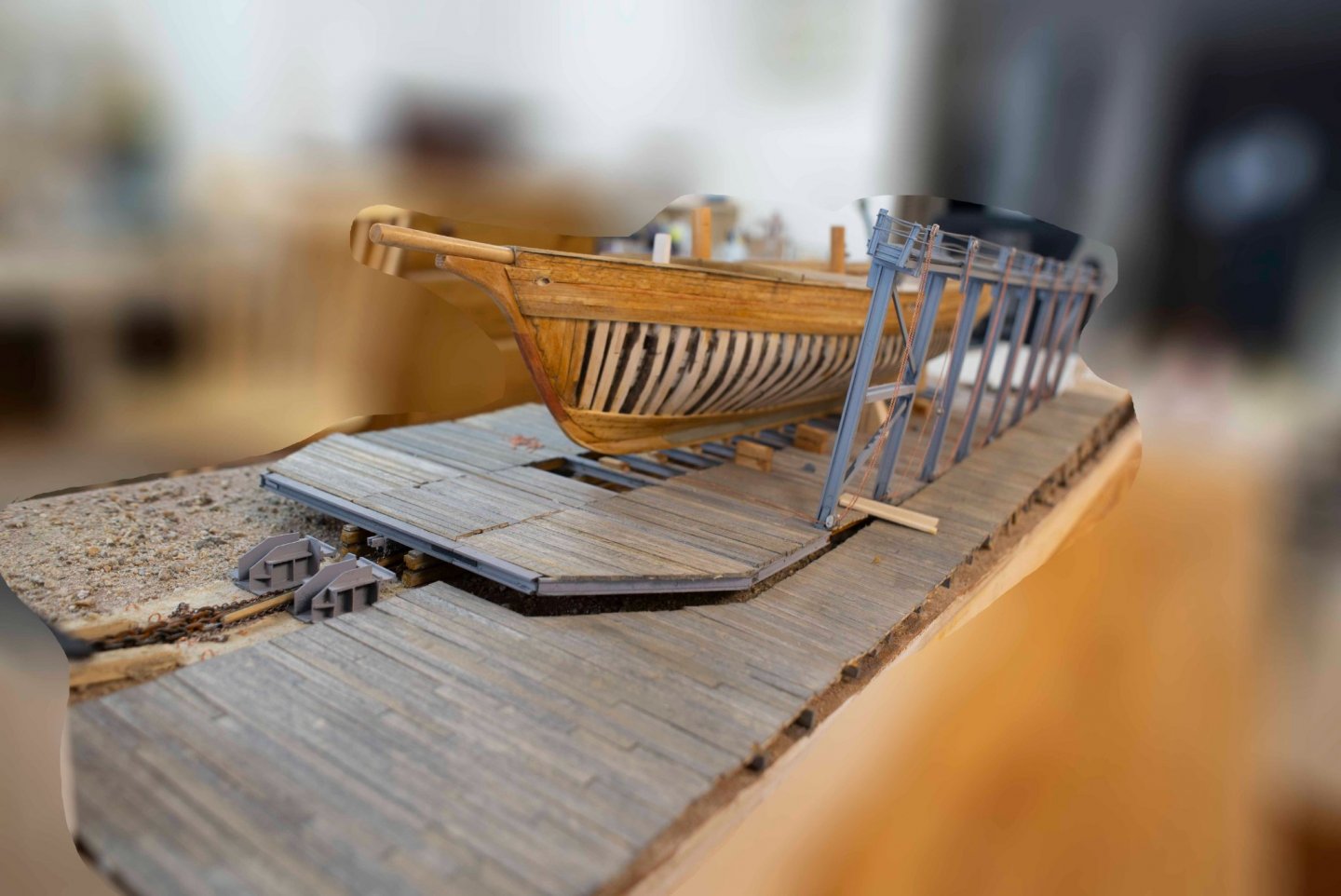
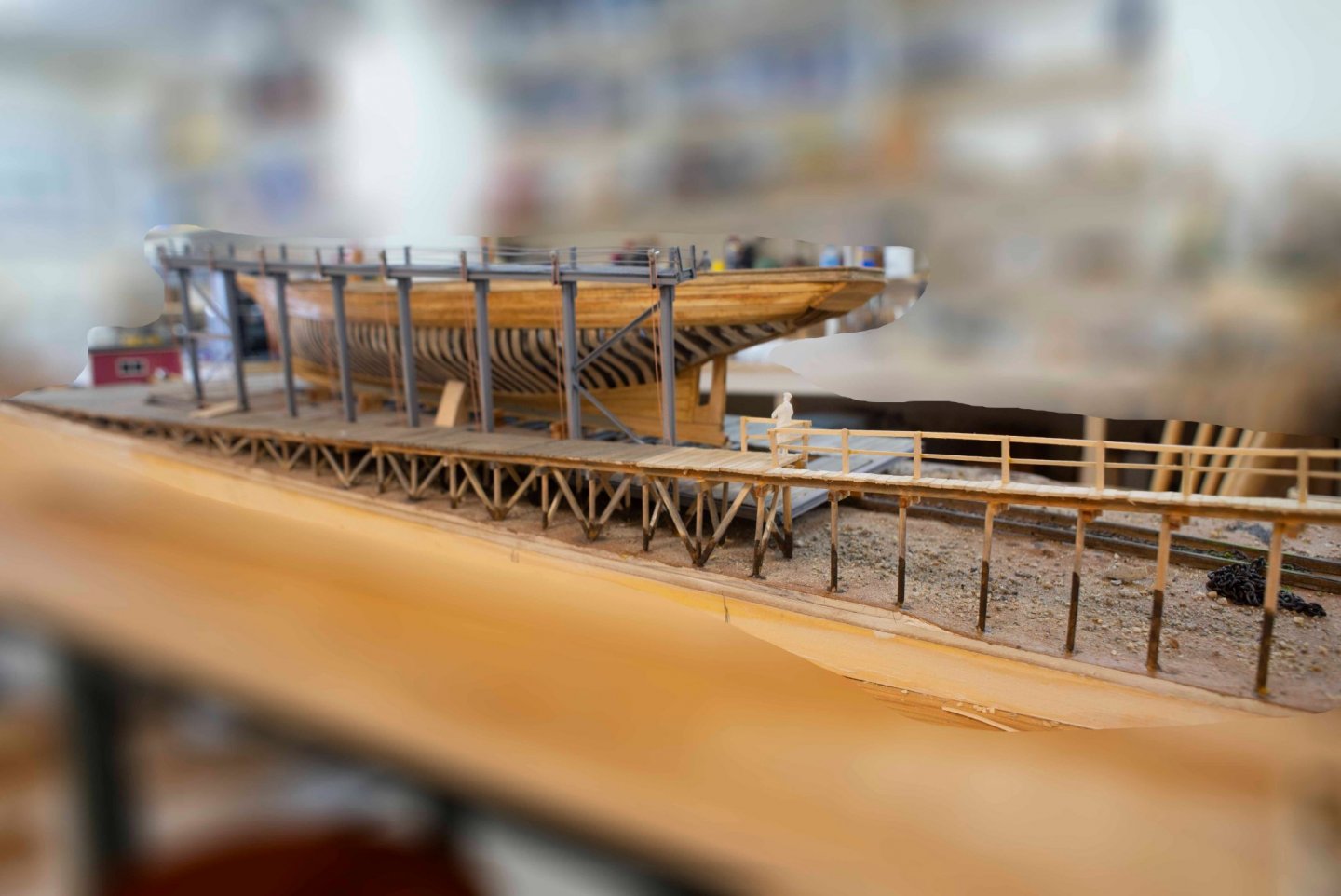
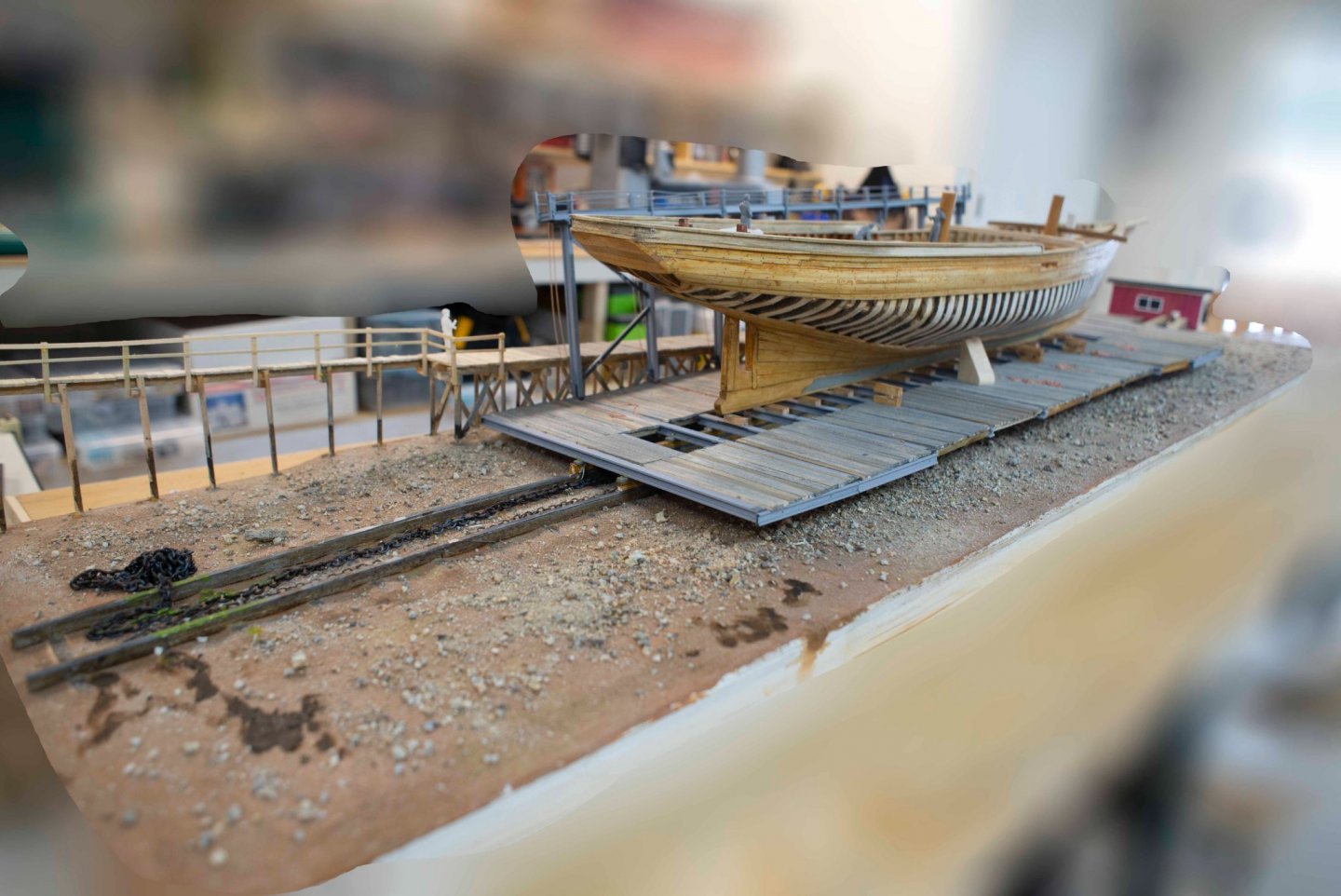
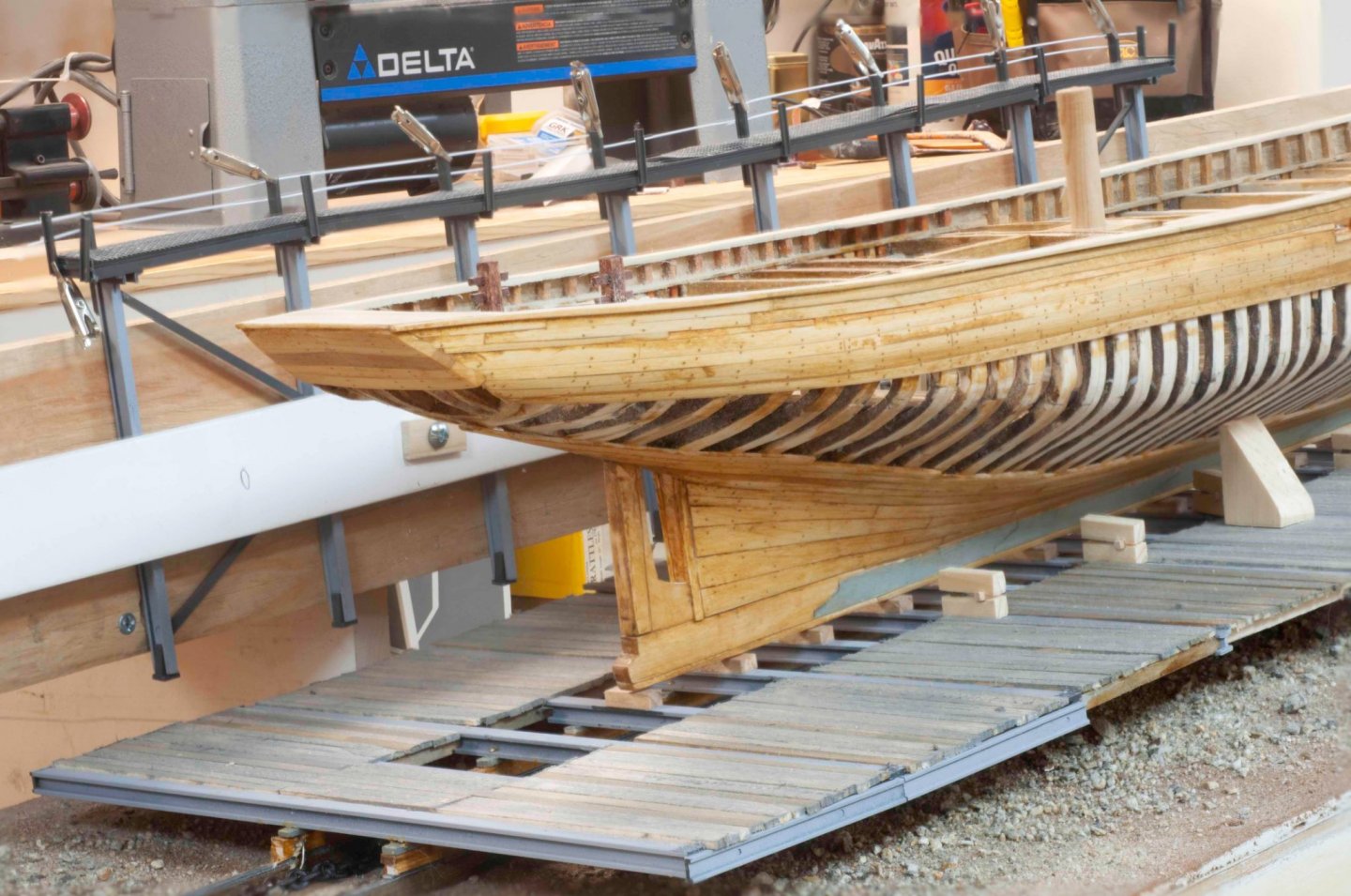
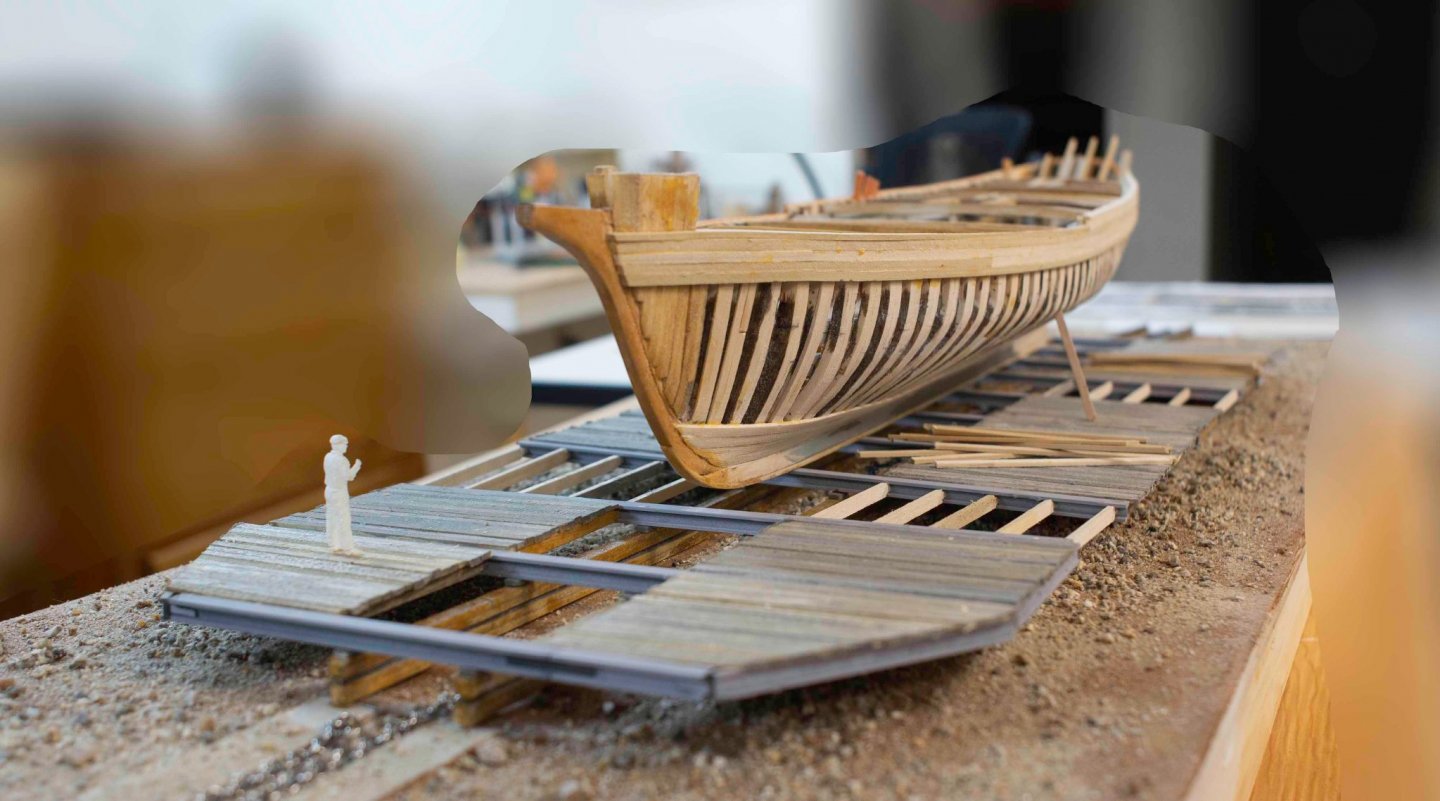
Bluenose by Jond - 1:24 scale - RADIO - Racing Schooner
in - Build logs for subjects built 1901 - Present Day
Posted
thank you Keith. it is something I needed to do. I have a few others that i need to drop back on too. we'll see how it goes
cheers